 By Staff By Staff
August 5th,2021
BURLINGTON, ON
Friday night DOWNTOWN.
 There are places downtown that are just what we need at this point in our getting back to normal. The Chocolate Jam 7pm – 10pm
Location: Miss Bailey Brown Chocolates | 433 Brock Ave.
This is a promising night of music and talent….your talent!! Open mic for covers, original songs, karaoke, musicians, poetry and spoken word. The event is free & outdoor with limited seating. We also have it on good authority that they will be serving their famous Chicken and Waffles.
Live Music 8pm till late.
The Block Co. | 395 John St.
Join The Block Co. for cheese, charcuterie, wine and LIVE MUSIC every Friday starting between 8 and 9pm and going ‘till late! Stay tuned to their social media @theblockco2016 for musician announcements. Seating is limited, please call ahead to make a reservation. 289-337-9911
Live Music 10pm till late.
The Dicken’s | 423 Elizabeth St.
Head on over to The Dicken’s for their return of live music on Friday nights kicking off at 10pm!

 By Max Bowder: Local Journalism Initiative reporter By Max Bowder: Local Journalism Initiative reporter
April 5th, 2021
BURLINGTON, ON
Story walks have been set up in several Burlington parks over the last few months with the expectation of giving children an enthusiasm for reading as well as allowing them to enjoy the outdoors.
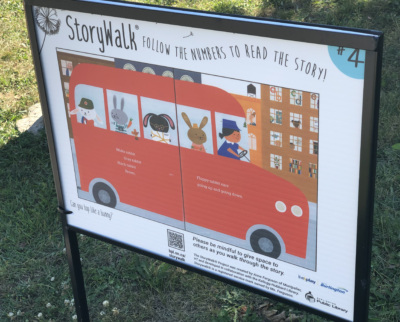 Different stories in different parks; a program that will be continued into the fall. The Story Walk was created by the Burlington Public library along with friends of the institution and the City Parks Recreation and Culture department, to create a new learning experience that allows learning to become more interactive and hands-on giving kids a more creative way to learn while also encouraging physical activity as well as literacy while children can enjoy being outside.
A Story Walk creates this fun by having a children’s story divided into a number of pieces and post each piece of the story down a walk way so that children can enjoy the outdoors while also searching for the next piece of writing in their story.
When children have a story in pieces, it encourages them to find the other pieces of the story which promotes literacy in the children while also giving them entertainment in searching out the story as a scavenger hunt while also letting children get out in nature and get exercise.
Story Walks are expected to become an effective teaching tool as it helps children in so many areas of their lives. One does not require a reservation – they can be visited any time of day.
The Walks are expected to develop children’s interests in reading stories and give them an initiative for the outdoors with it being an activity to be done with a teacher in a class or with parents on a walk.
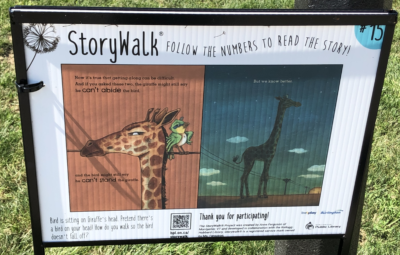 This is the story of a giraffe and a bird that comes to life 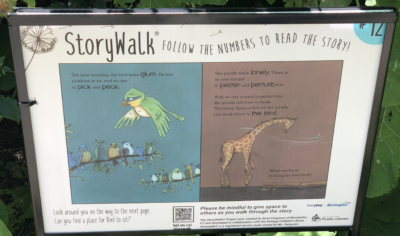 Walks from one story sign to another are like turning pages in a book. Not quite a chapter book yet. The Burlington public library will continue to put up more Story Walks in parks including:
• Centennial Bikeway, Longmoor Drive (Nelson Park area)
• Francis road bike trail, Francis Rd
• Central Park, 2299 New St
• Tansley woods trail, 1996 Itabashi way
• Sherwood forest park, 5270 Fairview St
Story walk locations coming soon include Lowville Park and Norton community park near the duck pond.
The stories in these parks will include:
 • The Thing Lou Couldn’t Do – by Ashley Spires, • The Thing Lou Couldn’t Do – by Ashley Spires,
• Families love Each Other – by Marcus Logan,
• Windows – by Julia Denos,
• Giraffe and Bird – by Rebecca Bender,
• Red house, Tree house, Little Baby Brown Mouse – by Jan Godwin,
• Water Only Please, by Camilla Judge-Aviss,
The stories are intended for children starting at age 3 – there is something in the story and the pictures for every elementary school student.
  Max Bowder is a second year journalism student at Sheridan College. He is part of a team with the Gazette on the Local Journalism Initiative funded by the federal government. Before enrolling at Sheridan Max volunteered in a community in Venezuela where he worked with young people. He is a Burlington resident who helps out on the family farm in Milton. Max Bowder is a second year journalism student at Sheridan College. He is part of a team with the Gazette on the Local Journalism Initiative funded by the federal government. Before enrolling at Sheridan Max volunteered in a community in Venezuela where he worked with young people. He is a Burlington resident who helps out on the family farm in Milton.

 By Staff By Staff
August 4th, 2021
BURLINGTON, ON
The public art program is continuing its annual Local Artist Program this year and has commissioned local artists who have created a variety of small to medium scale artworks throughout the community.
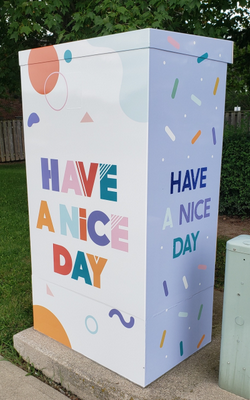 Hannah Brown, Have a Nice Day – Location: Walkers Line & Country Club Drive. “I decided to make my theme for this “Have a Nice Day” because years ago I would pass a bridge every day on my way to work, with some very amateur spray painted on it that said “Have a nice day”, and honestly, it made me happy to pass that every day. Living in a world with a lot of hate, fear, negativity and stress, it’s nice to find positivity in unexpected places. I want people to feel happy when they pass this, whether it’s just once, or every day during their daily routines.” The City has just installed the designs of 12 local artists on traffic control signal boxes throughout the city.
Artists were encouraged to submit artwork that focused on inspiring and uplifting the community during these challenging times.
This artwork forms an urban art gallery that can be experienced by residents while still practicing appropriate social distancing.
Artwork Locations
Intersection of traffic control box Artist
Appleby Line & Longmoor/Pinedale Teresa Seaton
Brant Street & Baldwin/Victoria Ryan Snook
Brant Street & Ghent Avenue Clover / Akuoko-Dabankah
Drury Lane at YMCA – IPS / Heather Kuzyk
Guelph Line & Prospect Street / Nicole Clouston & Quintin Teszeri
Maple Avenue & Mapleview Centre / Holly Allerellie
Lakeshore Road & Pearl Street / Jason Diesbourg
Lakeshore Road at Lakeshore Public School / Hannah Doherty
Pinedale Avenue & Bridle Wood / Janet Horne Cozens
Upper Middle Road & Duncaster Drive/Cavendish Drive / Tamara Kwapich
Upper Middle Road at M.M.Robinson High School / Cody Boucher
Walkers Line & Country Club Drive / Hannah Brown
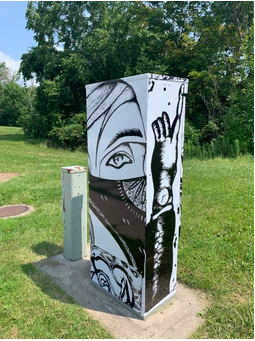 Cody Boucher – Location: Upper Middle Road at M.M.Robinson High School. ” My design is a collection of small fragments of my recent works, scattered together to form a single new piece. Over time I developed a prominent style I use in my hand drawn art which allows me to piece different drawings together in a “collage” style. Many of these drawings were completed during the COVID-19 pandemic as I have found myself with more downtime than usual. This has been the strange new reality we all share.”  Heather Kuzyk, Urban Life – Location: Drury Lane at YMCA – IPS “The concept of “Urban life” is a whimsical, anthropomorphic view of Burlington through the lens of indigenous fauna. Using bright, saturated pops of colour, and bold black and white subject matter, the concept is to convey four seasons in one day in a playful nod to Burlington’s diverse citizens as represented by the local wildlife population. Urban Life hopes to capture the lighter side of life in our fair city in a way that is relatable to both young and the young at heart with a gentle reminder that we are stewards of this beautiful land we call home.” 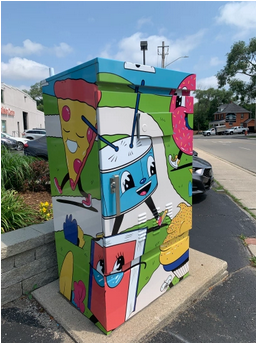 Ryan Snook – Location: Brant Street & Baldwin/Victoria. “The concept behind my work is to illustrate a vibrant, cartoon world showcasing some of best things our city has to offer. Great food, sports, The Sound of Music festival, our great libraries, and the RBG. All together on a landscape similar to our wonderful paths. The design responds to the diverse activities and people that enjoy our city and reflects them back using a cartoon world that brings out a playful nature.” CLICK HERE to see all the installations.

 By Mark Gillies By Mark Gillies
January 15, 2015
BURLINGTON, ON
Burlington is using the month of August to celebrate local history. Sometime ago the Gazette published a series of articles by Mark Gillies, a lifelong Burlingtonian. It is appropriate to re-publish the stories about the people who built this city. This is part two of the Spencer Smith story.
Spencer Smith got to Canada as part of the immigration of British children into Canada and Australia. The children were shipped from England by well meaning people but there were some horrific abuses and I believe it is necessary to expand the Spencer Smith story and learn more about how these boys who, without their consent became indentured servants. They were referred to as “Home Children”.
The poem Spencer Smith wrote, it was included in part 1, aches with the longings of a man who missed so much of a natural childhood.
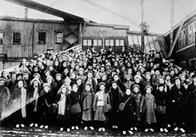 Home children on a dock in St. John NB – waiting for trains to take them east. The concept of Home Children started with honourable intentions; with good people trying to salvage young children from a parent-less home, or incredible poverty. Relocate them to a better life in Canada or Australia, that’s all they had to do. What’s the problem with that?
What made the idea work, was that farmers in Canada and Australia faced a severe labour shortage. They had recently immigrated themselves from Europe, cleared their fields, and grew their crops. Only problem was, who was going to do the harvesting, tend to the fields, feed the animals, and everything else that farmers do in this difficult labour intensive profession?
They didn’t have anybody to help. Governments were perplexed as well; those in Canada and Australia were more than happy to bring in immigrants to open up land and create farms. Sometimes they even gave them free land and supplies, but governments overlooked one part of the equation. Who is going work these large farms? They desperately needed a solution, and quickly.
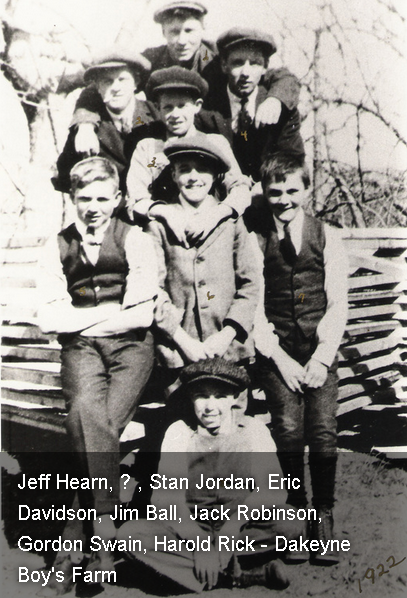 No doubt about it, everyone at the time believed this was a “WIN-WIN” situation. Spencer Smith’s story was a perfect example of one that seemed to have a happy ending. No doubt about it, everyone at the time believed this was a “WIN-WIN” situation. Spencer Smith’s story was a perfect example of one that seemed to have a happy ending.
Featherstone Martindale & Spencer Smith.
Spencer Smith’s sponsor was Featherstone Martindale from Caledonia. If you have ever been to Caledonia, it seems that about every third person you meet has the last name Martindale. They are a fantastic local family and they show up everywhere in Caledonia. Featherstone was born in 1848 in Haldimand County. Featherstone must not have been impressed by his first name, because he always went by the name Fred. He was a good honest man and a hardworking farmer who desperately needed help on his farm. Fred over the years became a father of 8 children and had married 3 times.
The Farmer’s Wife in Spencer’s Poem
In Spencer’s poem, he speaks of the farmer’s wife who influenced him. Spencer was referring to Eliza Mary Shult, who was Fred’s second wife. His first wife Eliza Jane Anderson died in 1881 after giving birth to a daughter named Ann. Fred married Eliza Mary Shult on January 8, 1883, and the new couple proceeded to have 7 children, the first born was Frederick who died in early 1884. Then another son named Featherstone was born in late 1884, and another 5 children were born between 1886 and 1895. In 2 quick years from 1883 to 1885 Eliza had married, and brought along her own small son named Wilfred McBride who was 5 years old from her previous marriage, when her first husband John McBride died from tuberculosis in 1879.
Spencer arrived on the farm May 21st, 1885 when Eliza Mary was just 28 years old. She was quite a busy young lady herself by the time he stepped down from the carriage. This young lady seems quite remarkable to me, since she still had some extra maternal time to still dote on young Spencer, something that helped shape his life.
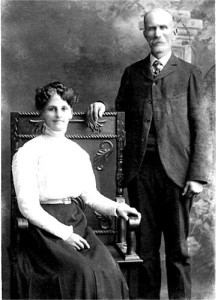 Eliza Mary Shult, the second wife of Featherstone Martindale had a huge influence on Spencer Smith, and he fondly recalls about her in his poem written in 1911. I’m sure old Fred would be quite crusty at times, and probably scared the lads half to death many more times, but Spencer’s poem has a softer edge to it, especially towards Eliza Mary. Eliza Mary died in 1895 from complications of the birth with her last child George Martindale. By this time, young Spencer had already left the Martindale farm. If Spencer actually stayed the full 3 years until he was 18, his servitude would come to an end in January 1888. After the death of Eliza Mary, Fred married a spinster named Margaret Anna Peart in 1907.
The Peart family in Caledonia, which is very large in number, just like the Martindale’s is somehow linked to the Peart family in Burlington, my guess is they are probably cousins. It’s only speculation, but the Jacob Peart farm in Burlington is on the land now occupied by Fortinos, Sears and Ikea, so maybe there was a connection for Spencer Smith to come to Burlington, especially if it was initiated through the Peart families in Caledonia and Burlington. The Peart farm was located directly across Plains Road from the Bell homestead. We’ll never know for sure, but we can at least think about it.
Spencer Smith was quite fortunate and did not face some of the severe hardships that other Home Children experienced. Far too many faced a certain hell of an existence.
The Truth about the British Home Children in Canada
Here’s what really happened to most of the British Home Children.
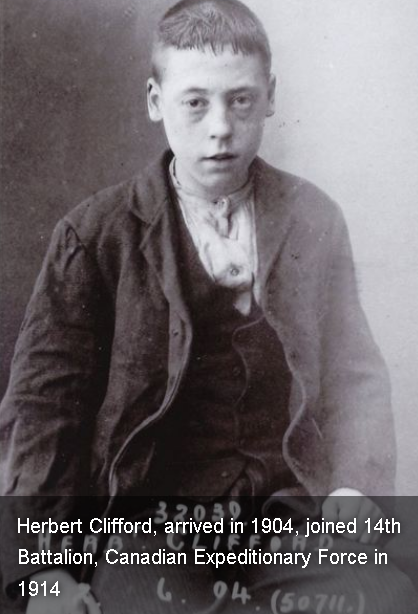 This became an economic issue more than anything else. It was strictly a case of supply and demand. Most of these organizations were faced with a huge demand. They had great difficulty in meeting the demand by farmers and governments in Canada and Australia. It was stated at one time that there were 10 applications for every child. So what were they going to do? The answer was simple. Start rounding up any child who potentially was wayward and lived in the area that was to be scoured for recruits. Overly simplified, absolutely, but not by much. This became an economic issue more than anything else. It was strictly a case of supply and demand. Most of these organizations were faced with a huge demand. They had great difficulty in meeting the demand by farmers and governments in Canada and Australia. It was stated at one time that there were 10 applications for every child. So what were they going to do? The answer was simple. Start rounding up any child who potentially was wayward and lived in the area that was to be scoured for recruits. Overly simplified, absolutely, but not by much.
The fact remains, that the original concept was for orphaned children. The reality was that only 2% were orphans. The rest were children in the wrong place at the wrong time. It’s true that during these times some parents had great economic problems, perhaps they were unemployed or seriously ill, and they had no choice but to hand over their children to a workhouse, or some other care facility until they could get back on their feet and then bring their children home. The truth is, these organizations to help meet the demand, decided to ship them overseas without their parents’ consent. Most of these children had no idea what was happening to them. The parents did not know either. The children never realized that they would never see their family again.
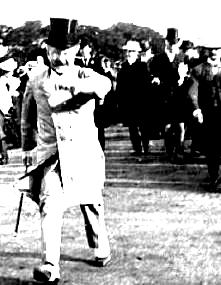 Dr. Thomas Barnardo was a very controversial character, and was responsible for exporting thousands and thousands of British children out of England and relocating them mainly in Australia and Canada. Here he is in 1905 leading the Founder’s Day Parade shortly before his death that same year. The largest organization was run under the management of its controversial founder Dr. Thomas Barnardo. He somehow convinced the Canadian and Australian Governments to take these children. Once that was established, then other organizations like the Shaftesbury Homes, the Salvation Army, churches, and others also jumped on the bandwagon. Probably, none of these add on organizations realized that down the road, this program was going to spiral way out of control, and thousands and thousands of small children were going to be totally exploited in this moneymaking scheme to supply cheap child labour to Canadian and Australian farmers. You can dress it up any way you want, citing testimonial cases that turned out good, reminding people that they were paid a small amount, some orphans were adopted by loving families, but in my opinion, the bare bones reality was: Canada, Australia and England were totally involved in a repulsive child slavery program.
Whatever happened to the other 32 boys who made the trip to Hamilton?
When I researched for information on the other 32 boys that made the trip to Canada with Spencer Smith, only about 2 boys continued to surface on available records. The Flamborough Historical Society has documented one of these Home Children. That boy went on to marriage, become a father and worked as a market garden farmer in Aldershot. He turned out okay.
Spencer Smith turned out okay. The others, they completely disappeared. We know some could have been adopted and had their surnames changed. As an outsider, it is basically impossible to track them. We already know that conditions for some children were so severe that they continually ran away from the farms they were working on, and many were beaten to a pulp when they were caught and returned. We know with documentation as proof that over two thirds of all the British Home children were beaten severely. We know that many of these children were not allowed to become part of the family that was caring for them. 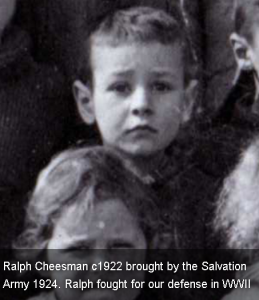 They were forced to live in exclusion on the farmer’s property, and not interact with the farmer’s own children or have any friends of their own. They were not loved or nurtured in any way. We know that they were constantly tormented and bullied by other children at local schools, and even adults participated in this human degradation of these children. We know that many just eventually disappeared. Where you ask? They were forced to live in exclusion on the farmer’s property, and not interact with the farmer’s own children or have any friends of their own. They were not loved or nurtured in any way. We know that they were constantly tormented and bullied by other children at local schools, and even adults participated in this human degradation of these children. We know that many just eventually disappeared. Where you ask?
My guess is some were probably murdered when they were beaten so severely by the farmers, and when authorities came around they just claimed that they ran away. Some children because of horrific living conditions probably became so ill, that they died on the farm, and were quietly buried on the property so as not to draw any suspicion. Others may have committed suicide, and became nothing more than John or Jane Does stashed away in a local morgue, waiting for no one to identify them. Whatever the reason, they’re gone, and we don’t know have explanations. Have a look at this story that appeared in the Saskatoon Star-Phoenix newspaper on April 23, 1930 about a young British Home Child boy named Arthur Godsall who was savagely beaten on a farm in Campbellford by farmer William Albert Hay, age 37.
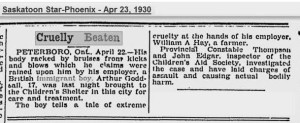 Albert had just arrived from England with many other British Home children and they all disembarked at Halifax from the ship Albertic on March 17, 1930. Albert had just arrived from England with many other British Home children and they all disembarked at Halifax from the ship Albertic on March 17, 1930.
Albert made his way to the Hay’s farm in Campbellford, and less than a month after he arrived he endured this beating and was finally rescued. That’s just one tragic story, there were thousands of stories just like this. One boy was forced to live outside in the dog house with the farm dog. The farmer fed the dog table scraps, and if the dog was full and if by chance there was any dog food left over, it was for the boy to scavenge. Not to mention that this same farmer viciously beat the boy almost daily. Eventually, he was removed from the farm, and as far as I know this farmer did not face any charges. This is unbelievable, but true. This happened in Canada. If you do some basic internet research, you will find these stories and many more.
What’s really disturbing is just how low profile this tragic event in human history was, and just how little we know of it now. But, it is becoming more widely known, and just recently as victims have finally come forward. In Australia for example, the Australian Government were finally brought to their knees by a public outcry after the public learned the truth from these victims, and the government brought forth an apology for their involvement in this hair-brained scheme. Also, the British Government were totally embarrassed by previous governments’ involvement in this tragic situation also came forth with an apology offered by then Prime Minister Gordon Brown. And what about the Canadian Government?
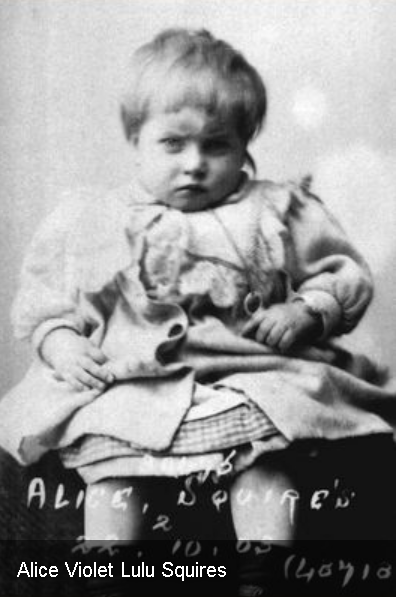 Where do we stand? Sadly, and unfortunately, the Canadian Government has essentially taken the position that this isn’t really a big deal, and no apology is warranted or forthcoming, even though they backed and encouraged this form of child slavery and abuse under the guise of helping disadvantaged children. Personally, I think that Jason Kenney the Cabinet Minister responsible for these remarks was not that well informed on the situation when confronted with the apology question, and consequently brushed it off as unimportant. I encourage you to contact Burlington’s local Federal Member of Parliament, Mr. Mike Wallace, who is a very decent man, and please voice your concern. I would like to think that Mike can champion this cause and help us get this apology from the Canadian Government. It’s long overdue, and it’s the right thing to do. Where do we stand? Sadly, and unfortunately, the Canadian Government has essentially taken the position that this isn’t really a big deal, and no apology is warranted or forthcoming, even though they backed and encouraged this form of child slavery and abuse under the guise of helping disadvantaged children. Personally, I think that Jason Kenney the Cabinet Minister responsible for these remarks was not that well informed on the situation when confronted with the apology question, and consequently brushed it off as unimportant. I encourage you to contact Burlington’s local Federal Member of Parliament, Mr. Mike Wallace, who is a very decent man, and please voice your concern. I would like to think that Mike can champion this cause and help us get this apology from the Canadian Government. It’s long overdue, and it’s the right thing to do.
Here’s how to reach Mike Wallace, Member of Parliament: Burlington Mall Office, 777 Guelph Line, Suite 209, Burlington, Ont. L7R 3N2. T: 905-639-5757 or F: 905-639-6031
House of Commons, East Block, Suite: 115, Ottawa, Ontario, K1A 0A6
T: (613) 995-0881; F: (613) 995-1091 or email, mike.wallace@parl.gc.ca
There is an incredible website on the British Home Children. https://canadianbritishhomechildren.weebly.com/
It tells the whole story of the plight of these exploited children. It will break your heart to read and watch some of the videos made by former Home Children, these men and women who are now elderly, who have finally broken their silence to tell the real story of what happened to them. The website also has a form that can be signed. It is a petition to persuade the Canadian Government to offer an apology to these unfortunate people, many still alive in Canada, and still suffering mental anguish.
Add the website to your “Favourites”. It is quite large and takes a fair bit of time to go through it properly, so you will likely have to go back several times. The website also is constantly updated with more unbelievable stories about this shameful part of our Canadian past.

 By Mark Gillies By Mark Gillies
January 12, 2015
BURLINGTON, ON
Burlington is using the month of August to celebrate local history. Sometime ago the Gazette published a series of articles by Mark Gillies, a lifelong Burlingtonian. It is appropriate to re-publish the stories about the people who built this city. Today we retell the story about the man the lake side park is named after – Spencer Smith.
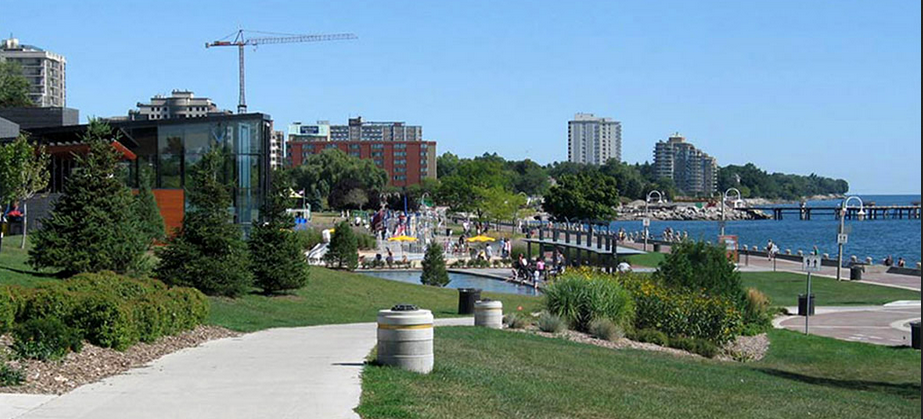 Here is Spencer Smith Park as it looks today; a park enjoyed by thousands of residents annually, all thanks to the vision of a single man. . One of the most recognized names in Burlington is Spencer Smith. We have named Burlington’s most scenic park in his honour. Spencer Smith Park, located on the shores of Lake Ontario, is used for many events that attract thousands of visitors annually.
We know the park; we really don’t know who Spencer Smith was, and just what it was that made him so significant to Burlington?
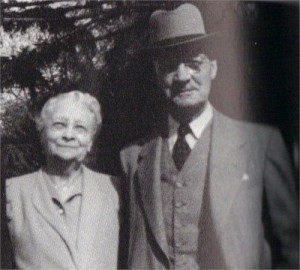 Spencer and Edith Smith a happy couple who enjoyed living and working in Burlington. If you read last week’s column on Edith Hodge, one of Burlington’s earliest settlers, you would have discovered that Spencer Smith was Edith’s son-in-law. Spencer married Edith and William Bell’s youngest daughter Edith Bell.
The Spencer Smith Story
Just how did Spencer Smith end up in Burlington, where did he come from, and what did he accomplish that made his name a Burlington household word?
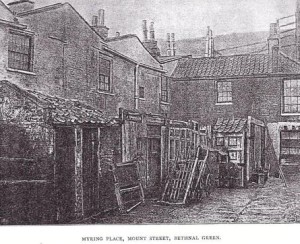 Spencer Smith was born at 7 Mount Street. This illustration shows what housing looked like on Mount Street around the time of Spencer’s birth in 1870. Spencer George Smith was born on January 18, 1870 at 7 Mount Street in Bethnal Green, East London, England to George Spencer Smith 26, and Mary Ann Mears 24. Spencer was the youngest of three children. He had two older sisters, Mary Ann who was born in 1866 and Sarah born in 1868. Spencer’s father worked as a labourer at a local wharf on the Thames River. Mary Ann was also employed, and most likely worked at or near the wharf and was responsible for folding the sails for ships, or as it was referred to in 1870, she was a furl server. Their residence may have been a tri-plex, as two other families lived at the same address. Edward Dwyer, a bricklayer and his wife Isabella, a tailoress, and their 4 children; plus George Scales, a cooper, and his wife Sarah and their 3 children all lived at 7 Mount Street.
Life in Bethnal Green during the 19th Century
Bethnal Green was a very poor neighbourhood, often referred to as a slum area. It was rundown, disease ridden, rat infested, everyone was exposed to raw sewage, the neighbourhood had a gut wrenching bad smell to it, and it was full of sickness, drug addicts, prostitutes, and uncontrollable crime. Bethnal Green was not the best place to raise your family. Bethnal Green was not unlike many other urban communities in England at that time. 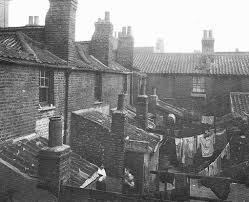
The Industrial Revolution had driven many people from their agricultural backgrounds into the towns and cities looking for work. These areas quickly became overcrowded, and living conditions seriously declined. Times were very bad.
For reasons that we do not know something happened to the Smith family. They basically vanished from the census records for 1880 and everything afterwards.
Death records have not been located proving conclusively that Spencer’s parents or sisters died, or moved elsewhere. Some have claimed that Mary became a widow, and that she had no choice but to give up her children, but this is just hearsay. It could be true. The only person we conclusively know about is Spencer Smith.
For whatever reason, perhaps to escape an imminent transfer to the local workhouse, which was a hideous institution located just down the street at 103 Mount Street. It was a derelict building having been in existence for over 120 year. Perhaps Spencer was to be turned over to an orphanage, we just do not know, but life for Spencer definitely changed. Did you know that workhouses were often the last destination for families that could no longer support their children, and parents were forced to turn them over to the authorities? Even orphanages were overcrowded and poorly run. Many parents died from disease, starvation, alcoholism, murder, suicide, or work related injuries. They left their children destitute, and there was no other recourse, but for these little people to end up in any one of these deplorable institutions.
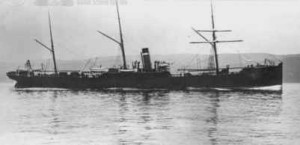 Spencer Smith and 32 other boys were sent to Canada on the SS Corean in May of 1885. This is the actual ship that Spencer made the voyage across the Atlantic Ocean on. Spencer in 1885 at 15 years of age was forced to leave his home and friends, board a steam ship named the SS Corean, along with 32 other boys all about his same age, and set off for Canada. The ship arrived in Montreal on May 14, 1885, and the boys made their way to Hamilton. They travelled on the Grand Trunk Railway, stopping all along the way, including Burlington, and finally on to Hamilton. Who knows, maybe Spencer looked out of the train car window when the boys pulled into the Freeman train station, and thought to himself, “This looks like a nice place. Maybe one day I will live here. Where am I anyway?”
Spencer and the other boys were sent by the Shaftesbury Homes organization based out of London, England. This organization and many others were operating in England, taking on the responsibility of relocating disadvantaged youth to Canada, and also Australia. The largest organization was run by Dr. Thomas Barnardo. It has been written that Spencer Smith was a “Barnardo Boy”, but that information is incorrect. This was a common error made by most people when they referred to the “British Home Children” shipped to Canada. The Barnardo organization was much larger than the other British organizations, the name ended up as generic terminology and just about all were referred to as Barnardo children regardless of the organization that sent them over.
It was believed at this time some British children would have a better life if they were removed from their local environment in their overcrowded communities and sent to Canada and Australia to live and work on farms. The concept was developed mainly for orphans, but over time this evolved into destitute children becoming included as well.
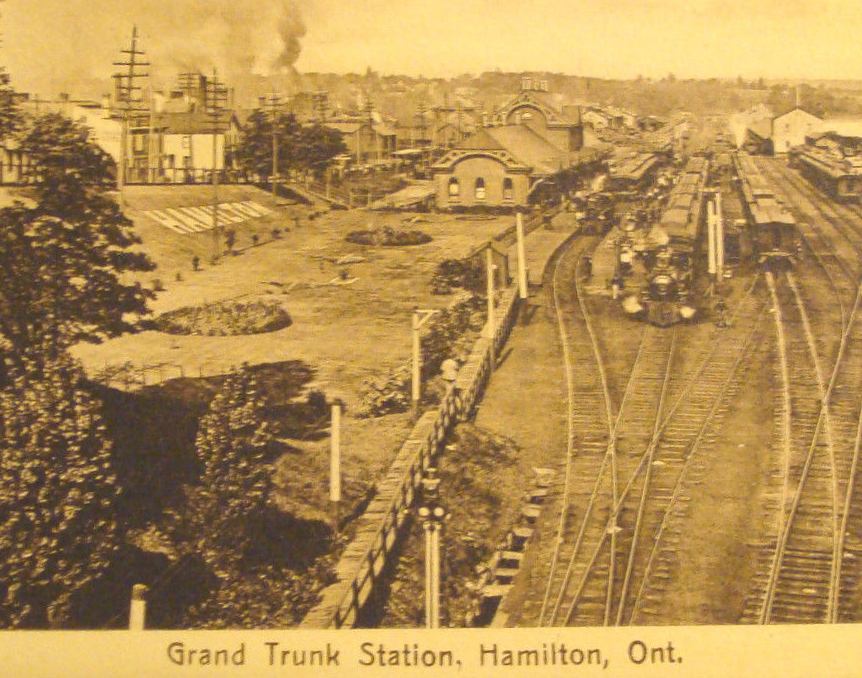 When Spencer arrived by train destined for Hamilton, he disembarked at this Grand Trunk Railway Station located along the southern shores of Burlington Bay. When the Grand Trunk Railway train arrived in Hamilton, the Shaftesbury boys were sent to live temporarily at a location called a “Receiving Home”.
In Hamilton it was called, “The National Children’s Home & Orphanage” which opened in 1884. This home was located on Main Street, in the east end of Hamilton on the grounds of present day Gage Park.
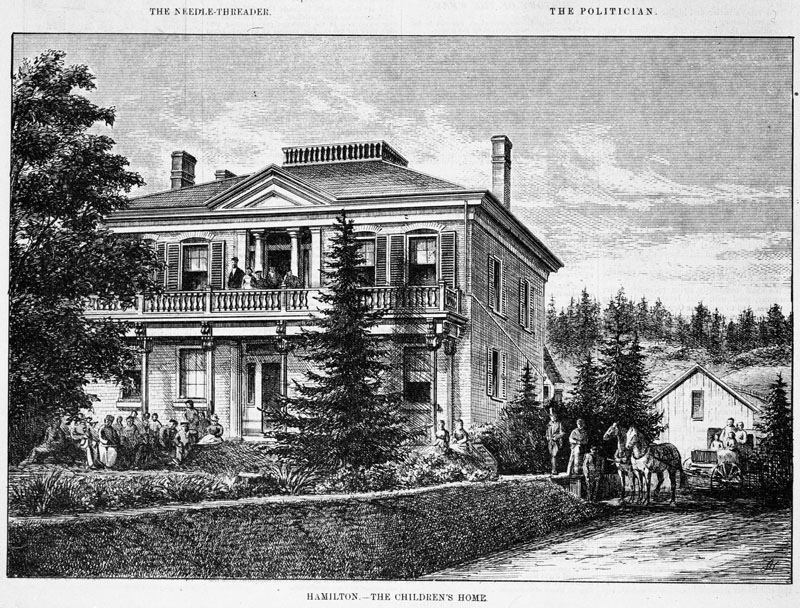 Spencer and the 32 other boys were sent to this “Receiving Home”. It was called the “National Children’s Home & Orphanage”, located on the grounds of present day Gage Park. When the boys arrived, farmers in the Niagara area who had sent in an application to be a sponsor for these children were notified that the children had made it to Hamilton, and they were now ready to be picked up and taken to their new home. Not all children were sponsored before they arrived, it depended on the circumstances that brought them to the “Receiving Home”. In some situations children had to wait for someone to come along and claim them. “The National Children’s Home & Orphanage” over time evolved into Canada’s Children’s Aid Society. Shaftesbury Homes in London, at a later date, became the cornerstone of the London Children’s Aid Society.
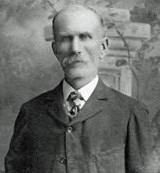 Featherstone Martindale was the farmer from Caledonia who sponsored Spencer Smith taking him back to his farm to begin work as an indentured farm labourer. For Spencer Smith, a farmer named Featherstone Martindale from Caledonia was coming to pick up him and probably a couple more boys too. We know that other boys also went to Caledonia to work on the Martindale farm, but we do not know how many. Most likely it was no more than 2 more boys. They met, and all got to know each other a bit better, and eventually Featherstone, the other boys, and Spencer left “The National Children’s Home & Orphanage”.
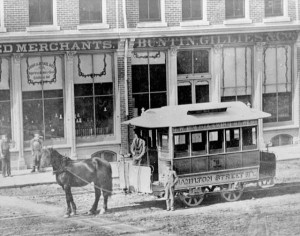 Before the Hamilton Street Railway streetcars became electrified, they were horse drawn. Featherstone Martindale and Spencer Smith and the other boys made their way to the King Street train station on a streetcar just like this one, for the train trip to Caledonia. The group travelled west along King Street in Hamilton on a horse drawn Hamilton Street Railway streetcar to the King Street train station at Ferguson Avenue, embarked on to the train and made the trip to Caledonia. That day was Thursday, May 21, 1885. When they arrived at the Caledonia station, Featherstone, the other boys, and Spencer travelled again for 6 miles, this time in the Martindale’s fancy carriage and on out to the Martindale farm in rural Caledonia.
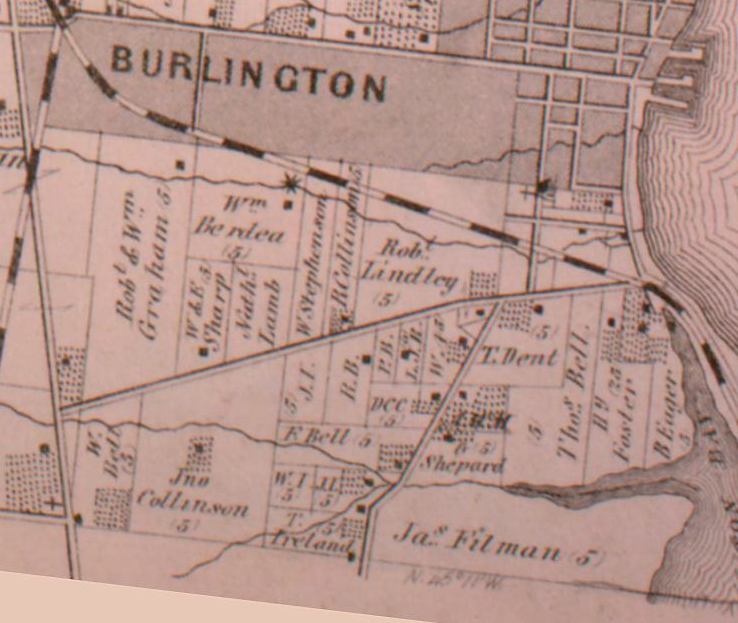 The farms along Maple Avenue provided the country with some of the most fantastic fruit grown anywhere in the world. If you look closely on this map, you can see the Lindley farm where Spencer worked, and also in the lower left corner you can see the William Bell homestead where he worked following his employment with the Lindley family. Spencer Smith’s new Canadian life was about to get underway.
The usual arrangement was to keep a British child on the farm, as indentured servants until they became 18 years of age. These children were to be paid a small wage, fed, clothed, schooled and provide room and board. According to Spencer, he agreed to stay at the Martindale farm for one year. This could be true, or not. We’re not certain if Spencer stayed with the Martindale’s for up to 3 years, or if he went to another farm. We do know that Spencer in 1889 was working as a farm labourer on the Lindley farm in Burlington when he was 19 years old. The Lindley family operated a very successful orchard farm on Maple Avenue. It was located just north of Water Street, now called Lakeshore Road, and it ran north up to about the south side of Mapleview Mall.
The Lindley’s were smart farmers and during the Great Depression, just to stay in business, negotiated a deal with Dominion Stores and supplied the grocery store chain with produce, an agreement so good that it lasted for over 40 years. For many years, the Lindleys and other local farmers hauled their crops by wagon up to the Freeman Train Station, and loaded up the boxcars with their products for transport to markets across Ontario, Canada, England, and even South Africa. The Freeman Station (now under restoration on Fairview Street and in need of more private funding) was the focal point of Burlington’s emerging agricultural market. It was Burlington’s “Window to the World”.
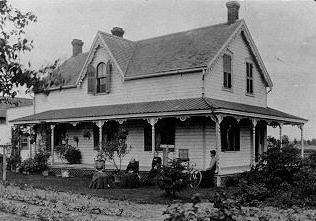 Here’s the Bell Homestead where Spencer Smith worked and met his future wife, Edith Bell. The homestead is still here today, although it looks somewhat different. You could call it, “The Home of the Strawberry Social”. One day, Spencer Smith left the Lindley family farm and moved up Maple Avenue to the William & Edith Bell farm located at the southwest corner of Plains Road and Maple Avenue, and he began working as a farm labourer for the Bell family. It was here at the Bell homestead that Spencer Smith met Edith Bell, the youngest daughter of William and Edith Bell. Spencer courted the farmer’s daughter, and before you knew it, they were engaged and then the young couple married on May 9 1900.
At that time, Maple Avenue went north and more westerly emerging at the Union Burial Ground, the historic pioneer cemetery located in front of the Sears, Fortinos & Ikea stores. It has been reported that Spencer Smith went to work on a farm in Penetang. Again, this is hearsay, and not proven. It is possible, but if Spencer did work on a farm in that area, it would have most likely been after his servitude was completed at the Martindale farm, and before he began work on the Lindley farm by 1889, or Spencer may have left the Lindley farm, went to Penetang and returned to begin working with the Bell family. We’re not certain.
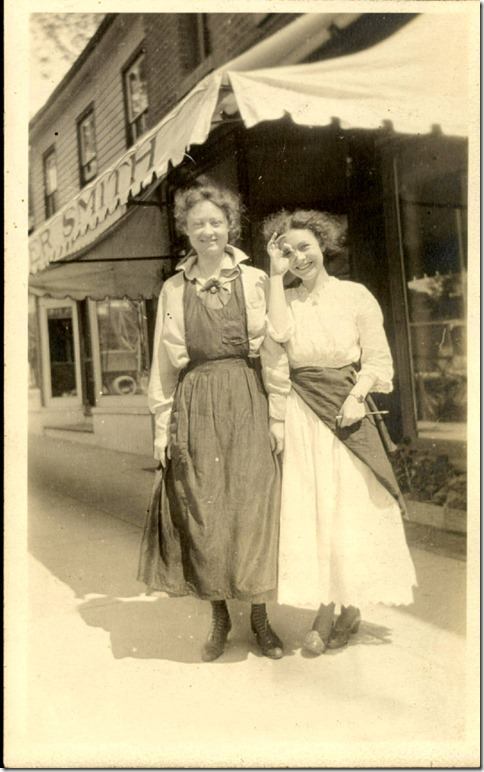 These two young ladies are standing outside Spencer Smith’s green grocery store on Brant Street, just north of Pine Street. The young lass on the right just may be holding a candy stick that was given to her by Spencer Smith. This rare photograph taken around 1914 shows the last part of the name Spencer Smith on the awning’s edge. Many thanks to local genealogist Russell Hunsperger for digging up this picture from his family’s photo archives. Spencer eventually became a green grocer, and opened a store in Toronto, but this did not last long and the couple returned to Burlington, where Spencer opened another green grocer store. This time it was on Brant Street, just 4 doors north of Pine Street, on the east side.
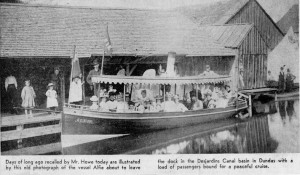 Spencer Smith’s grocery store attracted pleasure boat shoppers just like these passengers on the boat “Alfie” which set out from a dock in Dundas. The store was very successful, and eventually Spencer and Edith became quite affluent. Spencer Smith was a clever marketing man. Whenever children came into his store, they were treated with candy. There were other grocery store competitors in town, but Spencer usually won the day over the other stores. When the children in the neighbourhood persuaded their parents to go shop at Mr. Smith’s store, the parents usually agreed, not quite realizing why the children were so insistent. The other grocers in town probably couldn’t figure out why Spencer Smith’s store continually had so many customers. Spencer and Edith Smith were very good at business, and skilled as retailing entrepreneurs.
In fact, the store was so popular, that passengers travelling on recreational pleasure boats from Hamilton, Dundas, Grimsby, Bronte, Oakville, and other local towns often docked at the wharf located at the foot of Brant Street, just to shop at Spencer Smith’s store. Today, we call this shopping at “Destination stores”.
Spencer was a member of the Burlington Horticultural Society for 36 years, from 1919 up until he died in 1955, where he served as the Society’s President from 1931 – 1936. Other well-known local names served as President when the Society was started for a second time in 1919. The first President was Rev. George W. Tebbs, Rector of St. Luke’s Anglican Church who served in 1919-1920. William Arthur Emory, was Spencer’s brother-in-law and he served in 1925-1926. Paul Fisher served in 1921.
The Fisher family owned the orchard farm where Burlington Mall is located. Fred Ghent served in 1922. Richard Jerome “RJ” Alton served in 1949. The first Burlington Horticultural Society actually started in 1889 by the local market gardeners as more of an agricultural group interested in how to better grow market garden products. The second Society focused more on the beautification of Burlington. It was this latter Society that had the Rose selected as Burlington’s official flower, and to this day, area residents compete for the annual Rose Awards in recognition for residents’ beautiful home gardens.
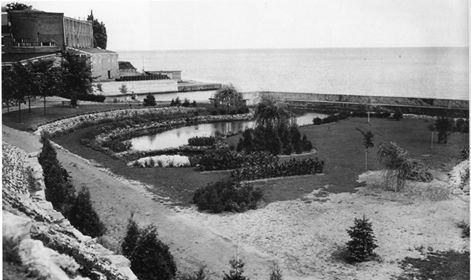 The Lakeside Park was starting to look more like a park. Over the years it continued to develop into a beautiful scenic park. The canning plant can be seen in the upper left as well as the dock that was at the foot of Brant Street. In 1933, Spencer Smith as President embarked on an ambitious project to beautify the land at the foot of Brant Street in Lakeside Park. During the Great Depression the canning plant employees located next door to the park were on strike, and Spencer utilized the strikers to help clean up the new park. It has been reported that Spencer Smith hired these strikers, but more realistically these were probably just volunteers who were quite bored being on strike. There certainly wasn’t much money available at the time, and Spencer was always looking for free assistance, wherever and whenever he could find it. Spencer himself, devoted countless hours of volunteer labour at the park.
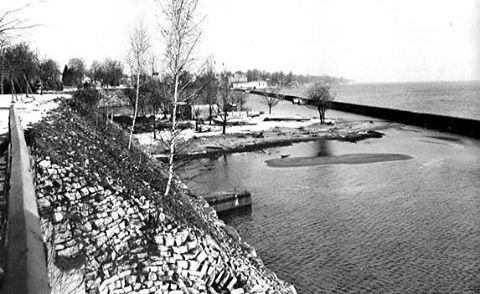 The new Department of Recreation after 1950 decided to add more fill to the water and expand the size of the park. The breakwater is clearly in place. Harold McGrath owned a local trucking company, and Spencer even enticed Harold to drop off any excess loads of rock or topsoil at the park, also probably done at no cost. Spencer had a clear vision for this park, and he was bound and determined to make it happen. The spectacular willow trees growing in Spencer Smith Park are not there by accident. Dorothy Angus the town’s librarian and friend to Spencer, lived on Ontario Street and had willow trees growing on her property. Spencer carefully removed willow tree cuttings and transplanted them to the park. Today, we can see the results of this undertaking. The park was an ongoing project for many years, and in 1942, the Town of Burlington finally recognized Spencer Smith’s accomplishments and named the park “Spencer Park”.
In 1950, the town created a Department of Recreation, and this department took over the management of Spencer Park. One of the first projects undertaken by this new department, was to expand the park with more landfill at the eastern end.
When the Town of Burlington, under the leadership of Mayor Lloyd Berryman, was looking for their own unique Centennial project for 1967, a decision was made that Spencer Park would an ideal choice for an upgrade. The plan was to fill in the entire water area out to the breakwater, and over to the Brant Inn on the far western side, once all of the boats sheltered behind the breakwater were evicted. The Burlington Centennial Committee was created and received the go-ahead for the creation of the new park, and when the park was completed in 1967, they made one very serious error in judgment and attempted to recommend a completely different name for Spencer Park, which was abruptly objected to by The Burlington Horticultural Society and many other concerned local residents who were extremely upset that Burlington’s heritage was once again facing erosion, and quite possibly Spencer Smith’s hard work, commitment, and dedication to his park were about to be permanently removed. The Burlington Centennial Committee reluctantly realized their error, and eventually backed down giving way to a new name, mutually agreed to by everyone on both sides, it was to be called Spencer Smith Park, a name that still stands to this day.
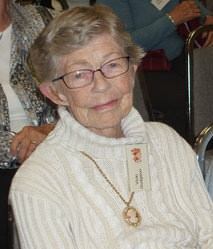 The great grand niece of Spencer Smith was the former Victoria Emery, and after marriage we knew her as Vicki Gudgeon, a local historian and a past President of the Burlington Historical Society personally knew Spencer Smith very well. Spencer didn’t stop at his park. Many of the streetscape trees growing in downtown Burlington were planted by The Burlington Horticultural Society. Burlington didn’t become so scenic and beautiful by itself. Credit should go to those dedicated members of The Burlington Horticultural Society. The property next to Central School was a seedling centre, and the Society grew new plants there which were eventually transplanted throughout Burlington. Spencer Smith’s great grand niece, Vicki Emery Gudgeon, who served as President of the Burlington Historical Society in 1975 -1976 recalled in an interview on the life of Spencer Smith for The Hamilton Spectator in 1989, that all of the trees planted by Spencer Smith and the Horticultural Society on Brant Street were removed when street lights were installed. Vicki stated back then, “I don’t think it was a fair exchange,” I think we can all agree that street lights on a treeless road are not as beautiful as a tree lined road. Vicki had the pleasure to really know her great grand uncle and described him as, “a very kind gentle man, and a gentleman.” She went on to say, “he looked a bit like Charlie Chaplin, because he had the same kind of moustache.”
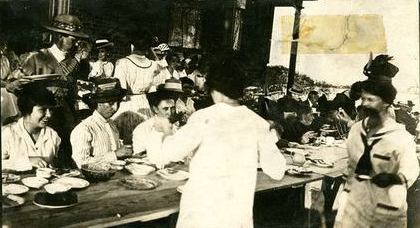 The Strawberry Social was an event that Spencer Smith, his wife Edith, the Bell family, and just about everybody else in Burlington looked forward to every year in town. Here’s Spencer serving up some more treats at the historic Willowbank on King Road. Over the years that Spencer Smith lived in Burlington, things changed, sometimes unexpectantly. Even though Spencer and Edith never had children, they still devoted much of their time to the betterment of Burlington. For example, Spencer and Edith both loved the Strawberry Socials, an event developed by the Bell family, and participated wholeheartedly in making them a rousing annual success in Burlington.
In 1924, after a beautiful 24 year marriage, the blissful happy couple faced a very serious challenge. Edith was not well, and soon became extremely sick. Edith developed pancreatic cancer which eventually spread into her liver, and this lovely, petite, gentle lady died a painful and tragic death on March 21, 1924, in the prime of her life at 54 years of age. The shocked and devastated Spencer buried his beloved Edith in historic Greenwood Cemetery on March 24, 1924. Spencer’s world of new found joy and happiness had ended with pain, and he proceeded to mourn his loss alone, and live a life that seemed to have no purpose.
Spencer continued to operate his grocery store on Brant Street for two more years, he was just putting in time; Then he met a middle aged lady who would become his next wife. She was known as Lillie, but her birth name was Elizabeth Anna Smith. Lillie was born June 7, 1870 in Whitby, Ontario to Thomas Henry Smith and Sarah Smith, a pioneer farm family who lived in the Whitby area for many years. It is not known where and when Spencer met Lillie, but we do know that this was the first marriage for Spencer’s new wife, and it seems a little bit humourous to me that Lillie changed her maiden name from Smith to her new married name Smith. It’s not too often that couples wed each other with the same surname, but it happened here.
Lillie’s new home was to be at 40 Locust Street. I am not certain as to when Spencer purchased this home. We do believe that Spencer and Edith had lived over top of their Brant Street store for a few years.
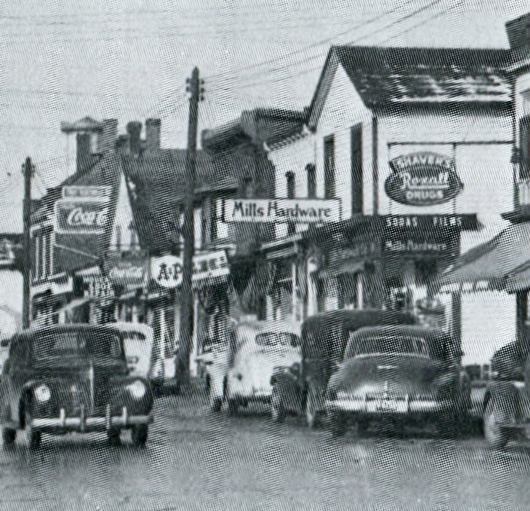 This photograph shows the A & P store that replaced Spencer Smith’s store in the same location. The photograph was taken in 1947 before the A & P moved farther north up Brant Street later that same year. The “modern” looking car in the photo is a 1947 Buick. This vehicle establishes the year of the photograph. It has been reported that Spencer Smith retired from work in 1950 when he would have been 80 years of age. I disagree, but I could be wrong. Although, I do not know exactly when he retired, it was most likely when Spencer was around 65 – 70 years of age in 1935 to 1940. I say that because Spencer Smith sold his store to the A&P Food Store company. A&P came to Burlington around that time, and Spencer was ready to call it a day. A&P took over his location and stayed there until they relocated farther north to a new store on Brant Street which opened in 1947. There are no records that we can locate of Spencer working elsewhere after that time, but he did continue to volunteer his time.
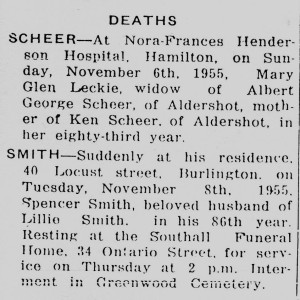 Spencer Smith’s Death Notice appeared in the Burlington Gazette newspaper on November 9, 1955 on page 14, column 3. The town was deeply saddened to hear of the passing of one of Burlington’s greatest citizens. 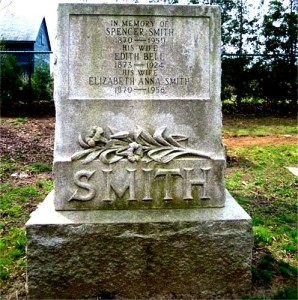 Spencer Smith, his first wife Edith, and his second wife Lillie are buried in historic Greenwood Cemetery. On November 8, 1955 Spencer Smith peacefully passed away at his residence at 40 Locust Street. He was buried alongside his cherished wife Edith in historic Greenwood Cemetery. The following year in 1956, Lillie, Spencer’s second wife passed away at 85 years of age, and was interred with Spencer and Edith in Greenwood Cemetery.
The full life and times of Spencer Smith was now over, but not forgotten.
Spencer Smith left us with a poem that he composed in 1911. He called it “Reminiscences”. In poetic phrasing Spencer captures some of his memories that changed his life.
Reminiscences
‘Twas six and twenty years ago,
And perhaps a little bit more,
When I, a lad of fifteen years,
Lit on this fair Canadian Shore.
Fate led the way to Hamilton,
And there a man I met,
Who said a likely boy to do the chores
I certainly must get.
I don’t think I looked likely,
For the voyage had been rough,
And leaving home and friends behind,
I felt most mighty tough.
But the farmer thought I’d suit him,
If I’d try and do what’s fair;
So we came to an agreement,
And I hired for a year.
We boarded the train at King Street-
I’ll never forget that day;
It was in the spring of eighty-five,
On the twenty-first of May.
My thoughts were busy all the way,
On the new life I was now to begin;
To me the prospect seemed gloomy,
And my future loomed very dim.
We arrived at Caledonia,
And the farmer’s old bay mare
Soon took us down the river road
To the farm, six miles from there.
The buggy we rode in was classy,
The roads none I’d seen could compare-
We took so much on the wheels as we went
It’s a wonder there’s any there.
My boy courage rose as I entered the house,
And I saw the farmer’s wife.
I’ll never forget her as long as I live;
And bless her all my life.
I had my tea and went to bed,
And slept as sound as a trout.
And the first thing I heard in the morning
Was: “Come, boys, it’s time to get out.”
I put in that day in a hazy way;
For a lonesome boy was I,
And as I drove the cows to the fields
I heaved many a deep, deep sigh.
Each day was filled with surprises,
And, Oh, the mistakes I did make!
Were the things I broke put together
They’d be worth all the wages I’d take.
The farmer was often impatient;
And often discouraged was I,
But one thing that kept up my courage
Was the farmer’s good wife and her pie.
The cows and the horses, the sheep and the pigs,
Were ever a worry and care;
But since I have left them I think of them still,
And in my dreams fancy I’m there.
The lessons I learned on the farm are worth more
To me than mere dollars and cents;
And if I were privileged to start over again,
It’s life on the farm I’d commence.
The farmer’s wife has gone to her rest,
But her influence lives in me still:-
She helped lift the load along life’s rough road,
And save me a start up the hill.

Part two of the Spencer Smith story will be published later this week.
My next article will be on Police Chief Lee J Smith, Burlington’s longest serving Chief. He was a no nonsense, tough as nails, compassionate man who faithfully served our community from 1916 to 1956. He saw it all over those 40 colourful years.

 By Mark Gillies By Mark Gillies
February 2, 2015
BURLINGTON, ON
Burlington is using the month of August to celebrate local history. Sometime ago the Gazette published a series of articles by Mark Gillies, a lifelong Burlingtonian. It is appropriate to re-publish the stories about the people who built this city.
Would you like to know who I think was one of Burlington’s great business leaders of the early 20th century? Many great people who lived here before us, sacrificed much to help shape Burlington; in order for us to benefit from our beautiful surroundings today. As a local society, we have in far too many cases, turned our backs on these great citizens of Burlington. This is a real shame, and it doesn’t have to be this way.
As in my previous articles, most of the people I write about will be names that you do not recognize, and are now reading for the first time. These outstanding citizens of Burlington accomplished much locally, but have never been properly recognized. One such person is Henry “Harry” Lorimer.
Harry Lorimer moves up the ladder with The Grand Trunk Railway
Harry was born on the family farm in Norfolk County, February 8, 1861. By 1891, Harry left the family business and pursued a career with the Grand Trunk Railway in Norfolk County. Harry’s first job was a telegraph operator, then he became a Railway Agent assigned to a station in Norfolk County, where he perfected his skills, before receiving a promotion that was about to relocate Harry and his family to a more fast paced location, the Burlington Junction Station in Freeman.
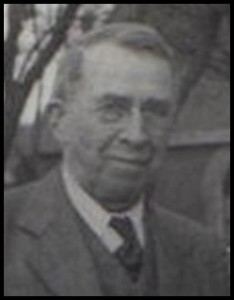 Harry Lorimer was the Burlington Junction Station Master in 1906 when it opened after fire destroyed the previous station in 1904. By 1897, Harry, his wife Seba, and daughter Gertrude were living in Freeman, and Harry was working as the Grand Trunk Railway Agent. It was very prestigious to be assigned as a Railway Agent to a Junction station. There was so much activity all of the time. Burlington Junction had double track lines running from Montreal right through to Chicago. Trains were travelling both ways. Then, the Grand Trunk Railway had another track running from the Niagara Region, across the Beach, through town, and up to Freeman where it crossed over the double tracks, continuing up to Georgetown, and then up to Allandale.
Burlington Junction also had freight warehouses, which were always busy with boxcars being loaded or unloaded. The responsibility and stress levels were extremely high for Harry Lorimer. The complicated schedules and logistics were unbelievable. Harry was lucky to have a telephone, some needed high tech assistance. The Station Master’s number was easy to remember. Who could forget “2”? Harry was the only Station Master for two different Freeman Stations. One burnt to the ground in 1904, and was replaced by another GTR station in 1906.
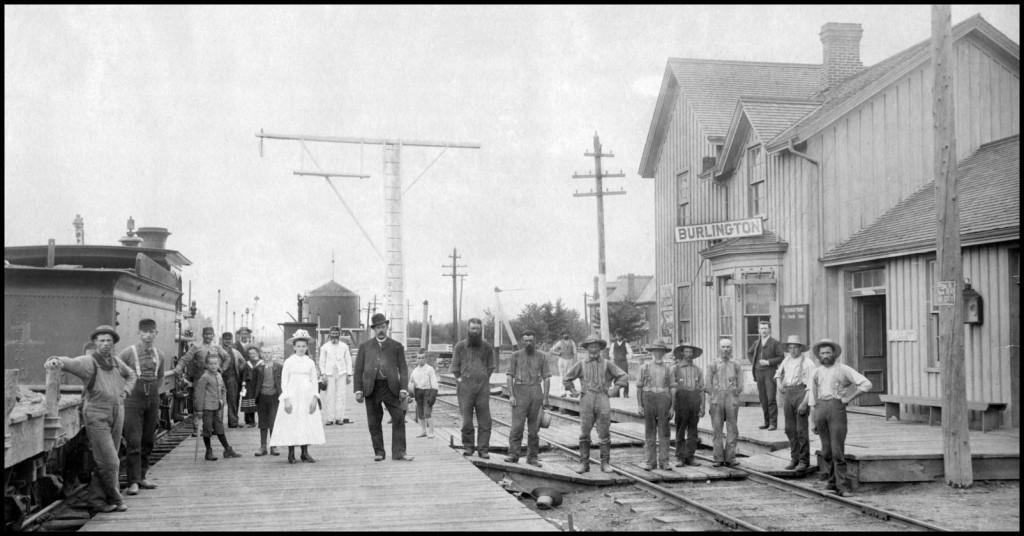 After a fire destroyed the original Great Western Railway train station in 1883, this second station was built by the Grand Trunk Railway, which also succumbed to a fire and was destroyed in 1904. Harry Lorimer was Station Master for both railway stations.  This is the historic 1906 Grand Trunk Railway Station photographed just after it had been built. The GTR identified the station as “Burlington Junction”. Our historic station was one of the busiest Junction stations in all of Canada. Now, thanks to the financial generosity of local citizens and businesses, this 109 year old historic building, owned by the City of Burlington, is in the process of restoration and has been permanently relocated to Fairview Street, west of Brant Street. The city owned 1906 historic station is now under restoration in a new location on Fairview Street, solely at the expense of private citizens and local businesses, who have come forward to save the station from demolition, as recommended by The City of Burlington. The City of Burlington at one time was to receive close to $1,000,000 in stimulus money to finance the relocation and restoration, but Burlington City Council, several years ago, were unsuccessful in agreement on a new suitable location. Subsequently the City of Burlington lost access to all of this stimulus money. Then, their solution to solve the problem on what to do with this magnificent old building, was a decision to have our heritage rich Freeman Station demolished, despite this being one of Burlington’s most historic buildings, and a huge part of Burlington’s colourful heritage. The citizens of Burlington were outraged at their thinking. Some on City Council still continued to fight to save our beloved Freeman Station and have been officially recognized for their outstanding efforts by the citizen organization, Friends of Freeman Station.
The Station Master was a highly respected citizen
The Station Master or Railway Agent in any town with a railway station was always a very influential and prominent citizen in their community. Railway Agents were very well respected, much like the clergy, police officers, doctors or lawyers. One of the reasons for this high level of respect was due to the fact that new families moving to Canada from Europe, arrived on the scene, and knew no one, often standing on the railway platform, suitcases in hand, and not knowing what to do, or where to go. The first person they saw and who offered to help them was the local Railway Agent. From meeting their first friend in Canada, new arrivals, one day, responded in kind. Often times, throughout Canada, the town’s highly respected Railway Agent also became the local Reeve or Mayor.
In 1901, Harry and his family were well entrenched into Burlington’s local community. Some of their good friends and neighbours were John Thomas Tuck and his family, plus the Ghent family, two very prominent local families. We’re all familiar with John T Tuck School on Spruce Avenue, and we all know where Ghent Avenue is located in Burlington. These two families have been recognized locally, but not so for Harry Lorimer.
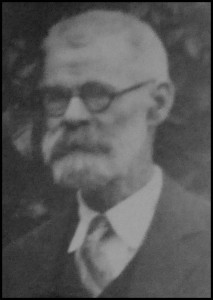 James S. Allen was the proprietor of Allen’s Hardware at the time it was sold to Harry Lorimer and Gordon Colton in 1912. James S. Allen was the nephew of George Allen, the previous owner, who then moved on to build prestigious homes in the core area of Burlington. James S. Allen, later became the Mayor of Burlington from 1925-1928. Harry Lorimer changes careers and Burlington wins again
In 1912, Harry, who was just 51 years old, made a career change. He became a hardware merchant and bought into an established business with his son-in-law, Gordon Colton. Together, they bought the hardware store, Allen’s Hardware, from James S. Allen, who at one time served as Mayor from 1925-1928. James Allen had previously purchased the business from his uncle George Allen in 1901. George had become Burlington’s most prominent home builder at the time, and was responsible for the building of many of Burlington’s historic homes in the downtown core, which was referred to as the Wellington Park area. The former Allen’s Hardware, was now called Colton & Lorimer Hardware store, and was located at the northeast corner of Brant Street and Pine Street. Their retail neighbour 2 doors north, was Spencer Smith’s green grocery store. I wrote about the remarkable Spencer Smith and his accomplishments in my article on January 12th. The hardware store, from the same location, operated as a thriving business well into the 1970s when it was owned by Keith Dale from Aldershot, and Keith operated it as Dale’s Hardware. Keith Dale purchased the store from the Mills family who had operated it as Mills Hardware, after they purchased it from Harry Lorimer.
 The Allen’s Hardware name was removed and the Colton & Lorimer name was added to the outside of the building in 1912. The historic building was located at the northeast corner of Pine & Brant Streets. This historic building met a fate all too familiar in Burlington, and was demolished. The retailing skills of Harry and Gordon were outstanding, as they both realized Burlington was growing quickly. Harry and Gordon understood that they needed to supply all of the local market gardeners with proper farm supplies, implements, and chemicals, plus they were also aware that new housing starts, and new building construction would provide incremental retail sales. To have everything in stock for both farmers and homeowners, and at the same time was a massive retailing nightmare. Big “Box stores” were not in Burlington yet, close to 100 years into the future, but Harry and Gordon knew exactly what would sell and what to stock in their store. Burlington was their market, and their shrewd retailing skills made Harry and Gordon very successful businessmen.
The Colton & Lorimer Hardware store was extremely successful, undoubtedly the most successful retail location on Brant Street, and most residents in Burlington shopped there. If you were lucky enough to have a telephone in Burlington, you could call Colton & Lorimer. Their number was “9”. If Colton & Lorimer didn’t have what you wanted, then you really didn’t need it. Colton & Lorimer had fine-tuned hardware retailing to a science.
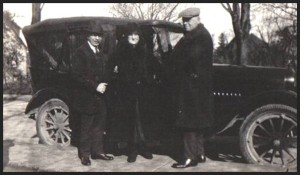 Harry Lorimer proved to be a superior retailer, and as a result the Lorimer’s attained substantial affluence. Along with the purchase of a custom made house, built by Burlington’s most prominent builder, George Allen; Harry & Seba also acquired a luxurious automobile and were driven about town by Bob, their chauffeur. With hard work, comes the spoils, Burlington’s on a roll
Harry and Seba finally decided to purchase a new home. They also decided to buy an automobile, and hire a chauffeur to drive them around. The hardware business was doing that well. The beautiful home they chose was built by Burlington’s most prominent home builder George Allen. Many of George Allen’s beautiful homes have now been designated as historical. The Lorimer residence was built in 1914 on a lot to the north of George Allen’s own historic house at 1391 Ontario Street. George Allen did not disappoint the Lorimer family. Their new home was stunning. The historic Lorimer family is at 504 Burlington Avenue, and the house just had its 100th birthday.
 George Allen built this beautiful home for the Lorimer family, and they moved here in 1914. The house at one time was recognized as historical, but in 2013 it was removed from the Registry by the City of Burlington for alleged lack of historical significance. City of Burlington insults Harry Lorimer’s legacy 50 years later
This beautiful home was lived in by the prominent Lorimer family for 50 years, from 1914 until 1964, and at one time was recognized as historical and added to the Municipal Register of Cultural Heritage Resources, then was officially removed from the Register in 2013 for what was said the be a lack of historical, architectural, or contextual value. (I know what you’re thinking, I’m not making this up, it really happened). The City of Burlington defends its heritage reasoning found on their website as follows:
What is Heritage Conservation?
“Heritage conservation involves identifying, protecting and promoting the elements that our society values. Heritage conservation has traditionally been associated with protecting the physical or built environment (buildings, structures, landscapes, facts etc.). More recently, the term has also come to be associated with safeguarding the non-physical associations between people and a place (associations linked to use, meanings and cultural or spiritual values).”Taken from Parks Canada Standards and Guidelines for the Conservation of Historic Places in Canada
Why is Conservation Planning Important?
The conservation of built heritage is an integral part of the land use planning process at the City of Burlington. It entails planning for the identification, protection and promotion of the heritage resources that our community values. Burlington’s heritage is a living legacy that helps us understand our past, provides us context for the present and influences our future.
Why Conserve our Heritage?
The conservation of cultural and heritage properties is vital to a community’s overall cultural and economic development and it can enrich our lives, inspire us and create a sense of community that can sustain generations. The Heritage planning process in Burlington is overseen by staff in consultation with the Heritage Burlington Committee.
The Passing of Harry Lorimer and his Family
Harry lived to be 99 years old, and passed away peacefully in 1960. His beloved wife Seba died 10 years earlier at 85 years of age in 1950. Gertrude, their daughter died at 76 years of age in 1964, and her husband Gordon tragically died at 31 years of age in 1918 as a result of the great influenza epidemic. They are all buried together as family, in Aldershot’s historic Greenwood Cemetery. All residents of Burlington owe a huge debt of gratitude to the Lorimer and Colton families. These two dynamic families were true genuine pillars of the community and did far more than their fair share in helping to build, shape and drive Burlington’s economic engine so efficiently into the 20th century
Plan to Attend Heritage Days
On Saturday, February 7th at Burlington Central Library, Heritage Days will be in full swing with many wonderful displays of Burlington’s local heritage featured for the public to view. Plan to take the children or grandchildren. It’s free to everyone. There will also be several guest speakers throughout the event. Heritage Days will be from 10:00 AM to 3:30 PM. One display you will not want to miss, will be the Burlington Junction Train Station 1:24 scale model. This beautiful model was handcrafted by Burlington resident, Mr. Bob Chambers. Thanks to Bob’s talents, you will get to see what life was like in 1906 when the historic train station opened, and Harry Lorimer was its first Station Master.
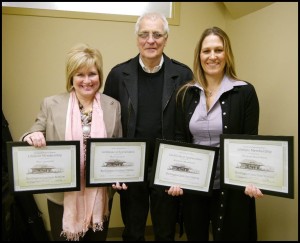 Councillors Marianne Meed Ward and Blair Lancaster, both heritage preservation advocates were recognized by the citizen group “Friends of Freeman Station” for their perseverance and leadership in convincing the others on City Council that the Freeman Station was worth saving. 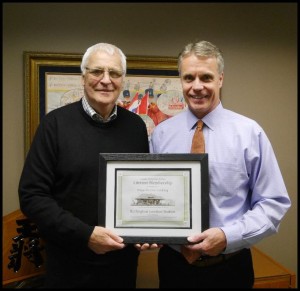 Mayor Rick Goldring was recognized by “Friends of Freeman Station” for his personal involvement in helping to save the Freeman Station from demolition, as recommended by the City of Burlington. Mayor Goldring received a Lifetime Membership to Friends of Freeman Station from Brian Aasgaard, President of Friends of Freeman Station. The Friends of Freeman Station will be there to answer all of your questions. Please plan to donate generously to help these exceptional volunteers complete the restoration of this magnificent historical building, something the City of Burlington could not accomplish. Without private financial support, this Burlington Junction restoration cannot be completed. There is no local, provincial, or federal government funding.
My next article on February 9th will be on the Burlington Junction Station, or as it is so often called, the Freeman Station. Find out why I believe Burlington Junction Station is Burlington’s most historical building, and why we need to make sure this part of our local heritage is preserved for future generations.
Related article:
What the Freeman Station really meant to the growth of the city; it was the key link in the transition of the city

 By Mark Gillies By Mark Gillies
Originally published January 5, 2015
BURLINGTON, ON
Burlington is using the month of August to celebrate local history. Sometime ago the Gazette published a series of articles by Mark Gillies, a lifelong Burlingtonian. It is appropriate to re-publish the stories about the people who built this city. The pictures are fascinating.
I chose Edith Hodge for my first venture into writing about Burlington’s fascinating historical roots.
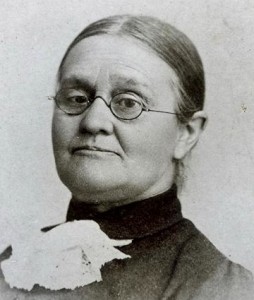 Edith Hodge, 1829 – 1925, a true local pioneer. Most Burlington residents have never heard of Edith Hodge, but by the end of this article, you will become much more familiar with this wonderful lady, and just how she has positively impacted Burlington. Edith is the perfect example of how life changed for many people of this era, who for whatever reason, left their homeland, and ventured into the New World as a pioneer, rooted themselves to their new environment, and provided future generations with the foundations of progress for a new society.
Edith Hodge came to Burlington in 1843 when she was only 14 years old, on a sailing ship that set sail from England and arrived in Montreal, Quebec. The voyage across the Atlantic Ocean lasted 7 long weeks. What’s unique about this voyage was Edith actually recalled her travel experiences and had them documented when she was in her 95th year in 1923, when she related the story to Marion North Blodgett (1891 – 1966).
There are not many first hand recorded recollections of life on these ships from immigrants sailing from Europe and settling in the New World. To have such information available from one of Burlington’s earliest residences is indeed quite rare and should be cherished for its historical content.
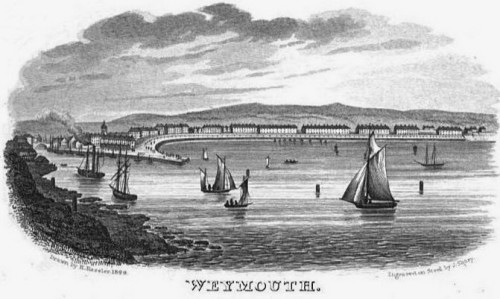 Edith, her mother & father, brothers and sisters were born and raised in Weymouth, England. This illustration shows how the village of Weymouth looked around the time the Hodge family decided to leave and relocate in Upper Canada. 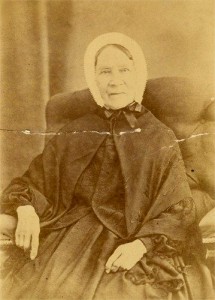 Martha Bartlett was Edith Hodge’s mother. Martha and her daughters made all of the preparations for the long and dangerous voyage across the Atlantic Ocean, then upon arrival in Montreal after a 7 week voyage made their way to Hamilton. Edith was born in Weymouth, England in 1829. With her mother Martha (1794 -1881), and 3 sisters Susan (1821- 1915), Mary (1825 -1899), & Emma (1834 – 1895) they travelled by themselves on this incredible journey. Edith’s father William Hodge (1790 – 1870), and her 3 brothers William (1827 -1899), James (1828 – 1897) & John (1837 – 1891) had already travelled the treacherous Atlantic Ocean much earlier, in order to set up a home, find a job, send money back home, and do everything necessary to bring the rest of the family over to a more comfortable lifestyle. It was not uncommon for families to split up like this, in order to better establish themselves in their new homeland.
Edith recalls the sailing ship had 3 masts, and had bricks as ballast. Ships on their return voyage to Europe were basically void of passengers, but were changed into freight ships loaded with lumber and grain, usually wheat, destined for the European market.
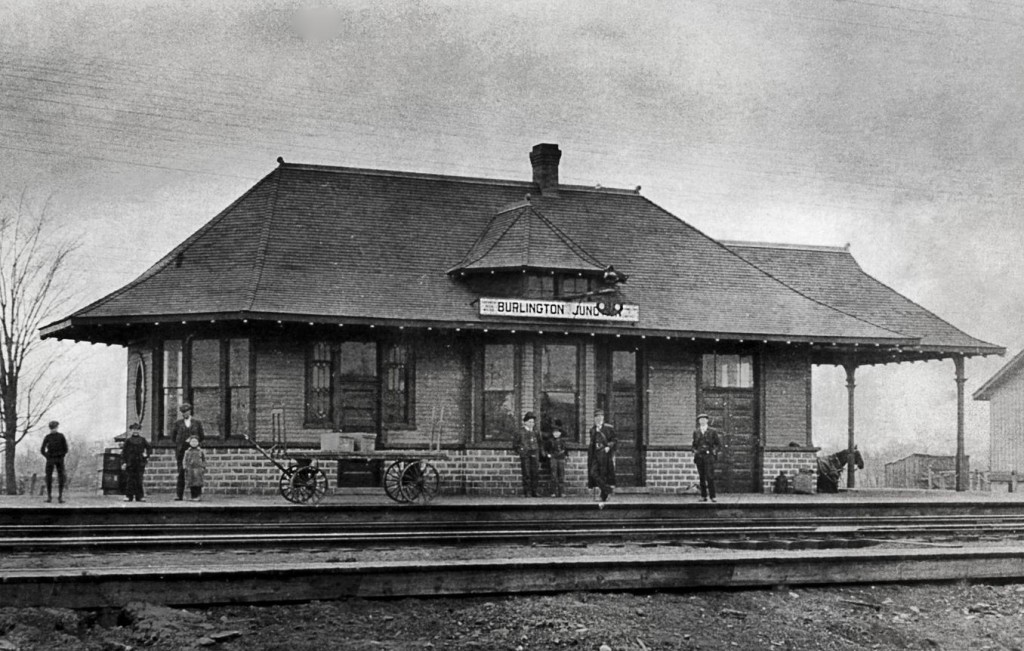 Historic Burlington Junction Station in 1906. As a matter of local interest, the historic 1906 Freeman Grand Trunk Railway Station now under restoration on Fairview Street has ship’s ballast as decorative stone work on the outside of the building. These are called “Whinstones”, which were quarried in the Midlands area of Scotland. To raise funds for the restoration work, 1,000 Whinstones can be sponsored with a tax deductible receipt for $100.00 each. To find out about sponsoring a Whinstone, just go to the Friends of Freeman Station website www.freemanstation.ca
Travelling by ship in 1843 was not anything like a cruise ship of today. It was not “All Inclusive”. The whole trip was extremely uncomfortable and very dangerous. Sickness and death were rampant. The ships were often called “Coffin Ships”. Burials at sea were an almost daily event. If you arrived alive, it was miraculous.
To travel, passengers had to bring their own food. Edith recalls the preparations that she and her mother and sisters made for the voyage. “We lived near a baker who supplied loaves of bread, which we cut and toasted before starting; also Mother cooked hams and prepared preserved fruits.” This information is quite insightful, as most of us have absolutely no knowledge of how these new settlers sustained themselves on a trip like this which lasted about 2 months.
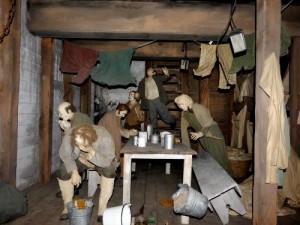 This illustration and the one to the right, show some of the horrific living conditions endured by passengers aboard a sailing ship travelling across the Atlantic Ocean, often in perilous weather. 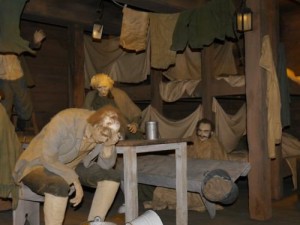 Another family from Weymouth, England were the Judds. They became the travelling companions of the Hodge family, and shared a compartment on the ship below deck. There was a low partition between the 2 families, and bunk beds for both. Edith recalls being mischievous on the long trip. “They used to call me down for everything.” Edith tells of the 2 families reading aloud to each other, often praying and singing. Another family from Weymouth, England were the Judds. They became the travelling companions of the Hodge family, and shared a compartment on the ship below deck. There was a low partition between the 2 families, and bunk beds for both. Edith recalls being mischievous on the long trip. “They used to call me down for everything.” Edith tells of the 2 families reading aloud to each other, often praying and singing.
During a huge Atlantic storm, when water was lashing over the bulwarks, passengers had to be fastened down below deck. The fierceness of the ocean tossed passengers violently on the ship. One of Edith’s sisters became so ill, that she removed her restraints and ventured onto the deck during this fierce storm. This was probably not the best of decisions, since sailing in oceanic storms can be very dangerous.
It was common to exchange food amongst passengers. The captain had fresh meat tied to the mast and sometimes would give the Hodge and Judd families some. The Hodge family had brought salted meat, and this was a welcomed change.
The Hodge and Judd families were very religious and took exception to some passengers playing cards. Edith said, “We didn’t have anything to do with them.”
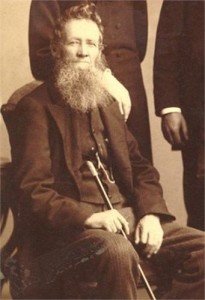 Aaron Dunham Emory was the man who loaned the money to the Hodge family which allowed them to purchase their farm in present day Burlington. According to Edith Hodge, Aaron Emory was “a real decent chap”. When the ship arrived in Montreal, the passengers had to stay in quarantine for 4 days, and once they cleared inspection, they were allowed to proceed. The Hodge family then travelled on a small boat which was pulled by a team of horses along the shoreline whenever they encountered rapids on the St. Lawrence River. Finally, this small boat made its way to Hamilton, and the Hodge women reunited with the Hodge men. William Hodge had already rented a home with a big garden. He began work as a gunsmith. The Hodge family stayed at this home for a short time, just long enough to figure out how to buy their own property. William and Edith then borrowed enough funds from Aaron Dunham Emory (1808 – 1892), to buy some farmland.
The Hodge’s had to remove tree stumps with oxen hitched to chains that were wrapped around the stumps. Edith stated, “You’d think it was a mountain coming up when the stumps gave way.” The cost to remove all of the tree stumps was $300.00, which was a huge amount of money in those days. The first crop planted was blackberries. The Hodge farm also had 2 cows. The family raised money by selling butter and blackberries at the Hamilton Farmer’s Market, which was used to pay off the interest on Aaron Emory’s loan. Edith recalled, “It was a great thing when we could pay off the borrowed money.” She called, Mr. Emory, “a real decent old chap”.
So how does Edith Hodge become more familiar to the rest of us in Burlington?
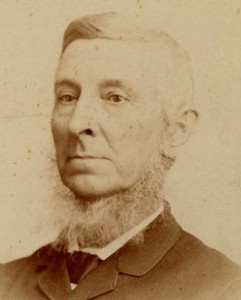 William Bell married Edith Hodge around 1850 and they proceeded to have 10 children . They lived a very good life at their homestead in Burlington. Around 1848, Edith met a man named William Bell (1826 – 1895) who she fancied very much, and the couple married around 1850. William Bell was born in England, and made his way to present day Burlington as a young man, and he then became a local farmer. His father Robert Bell and two of his brothers were shoemakers in Hamilton, and William was not interested in pursuing that career. Together, William & Edith Bell had 10 children. They are: James (1851 – 1935), Frederick (1853 – 1939), Elizabeth (1855 – 1936), William (1856 – 1942), Martha (1857 – 1932), John (1861 – 1947), Mary (1863 – 1962), Rhoda (1866 – 1957), Edith (1868 – 1871) & Edith (1873 – 1924).
William & Edith built the Bell homestead, which is still standing in Burlington. Thankfully, it has not been demolished, as so many properties of local historical relevance have been.
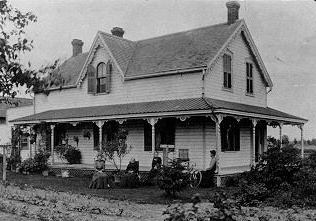 This photo shows the original Bell homestead photographed about 100 years ago. It is still in existence. This is the home of Canada’s “Strawberry Social”. What’s extremely important about the Bell homestead, is that William Bell introduced strawberries as a commercial agricultural product to Canada. Previously, people would usually have strawberries growing in a small container, maybe located on their verandah, and as people went by, they would pick one or two to eat.
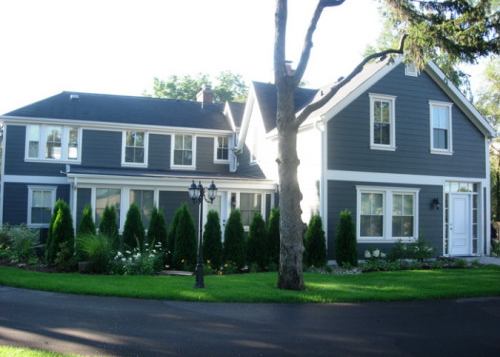 The Bell homestead is now called Bellview House. Today it is a conference centre. Look for the house when you exit the Ikea & Fortinos parking lot. When you turn left on Plains Road heading towards Brant Street, just look right as soon as you turn. It was William Bell, who had the vision of much more, and realized that this product could be grown in the fields, especially along Maple Avenue where the sandy soil was perfect for strawberry production, and then harvested, sold locally and also shipped to distant markets. William and Edith Bell were agricultural entrepreneurs who realized you could make a lot of money, just by growing strawberries.
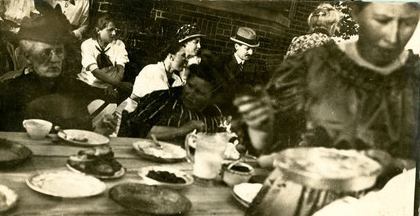 Here’s the “Strawberry Social” in full swing in 1916. The three ladies in front (L-R) are Mary, Martha and Rhoda Bell, three daughters of Edith Hodge. If you look closely at the photograph you can see a young dashing Spencer Smith in the background. The Bell family also were instrumental in using the “Strawberry Social”, as a very clever marketing tool to increase the sale of their strawberries. It became very fashionable to eat strawberries in Burlington, and around the country, thanks to William & Edith Bell.
Some of the Bell children married into many early local pioneer families. James, the eldest son married Jennie Fonger, (David Fonger was one of Aldershot’s first residents), Elizabeth, the eldest daughter married William Arthur Emery, (the Emery/Emory family are United Empire Loyalists), William married Frances Alton, (the Alton name is well recognized in Burlington), and Edith, the youngest child married Spencer Smith, a name known by everyone in Burlington.
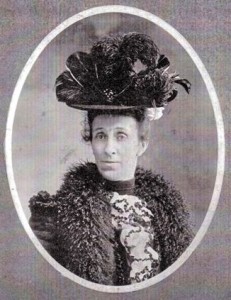 Another daughter of Edith Hodge was Elizabeth Bell. Elizabeth married William Arthur Emery, a successful market gardener in Aldershot. 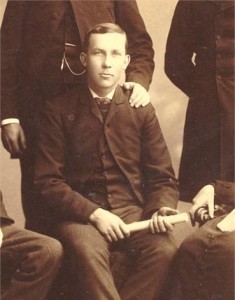 William Arthur Emery who married Elizabeth Bell was the son of Aaron Dunham Emory. Aaron Dunham Emory was born in New Jersey and came to the area as a United Empire Loyalist. 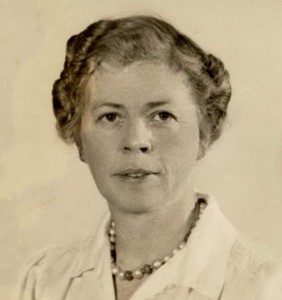 Marion North Blodgett was the lady responsible for documenting the recollections in 1923 of Edith Hodge and her experiences travelling across the Atlantic Ocean in 1843. This was not an easy task as Edith Hodge died of senility shortly thereafter. Today we know this as dementia. 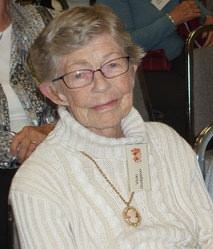 Ethel Victoria Emery is the daughter of Victor and Marion Emery. Today, we know her better as Vicki Gudgeon, a local historian and past President of the Burlington Historical Society. Elizabeth Bell and William Arthur Emery had 5 children. One son was Victor Harold Emery (1883 – 1966). Victor married Marion North Blodgett. One of their daughters is Ethel Victoria Emery. Many will better recognize this lady as Vicki Gudgeon, a former past President of The Burlington Historical Society, and a noted local historian.
Who knew?
My next article will be on Monday January 12, 2015. It will be on Spencer Smith, the son-in-law of Elizabeth Hodge. We all recognize the man who has his name attached to Spencer Smith Park, a park used and enjoyed by thousands of residents, but very few of us know anything about this very special man. Spencer Smith had an extraordinary life. Find out next week.
Mark Gillies is a lifelong resident of Burlington, grew up in Aldershot and developed as a local historian, researcher, master genealogist and writer who has a passionate interest and extensive knowledge of the many early pioneer families. Mark will write a regular column Who Knew?, about colourful local history introducing Burlingtonians to the people that made this city what it is today.

 By David Pringle By David Pringle
July 29, 2021
BURLINGTON, ON
South Korea is a solid economic country that is fully Independent and has very well managed. If we considered the coronavirus situation and its management, the government has been successfully placed under the lower level coronavirus effect that made its travel and economic corridor easier in times of pandemic. South Korea visa for Canadian citizens is not very easy to obtain because of the language barrier, of course, and the Korean district supervision for the security and safety of its own country.
 The wave of South Korean pop culture around the world hasn’t happened by accident – it was a deliberate government plan. But that doesn’t stop the economy and trade with travel from flowing into Korea because everyone is curious about its culture and, of course, Korean pop culture.
Applying for Visa and resident ship in South Korea has been currently closed due to coronavirus and pandemic situation. Still, travel to the country with a low risk of coronavirus Transmission has been allowed under the general guidance of coronavirus safety.
You will need to have a permit of K-ETA for any business travel or tourism for six months.
What Is K-ETA? Why Is It Required?
A South Korean visa for Canadian citizens is straightforward, and Canadian only require a passport to enter South Korea for 180 days without any permission. But still, they need every document and identification to stay inside the country. From September 2021, it is announced that South Korea will also require a K-ETA permit for Canadians.
It is a kind of visa and a permit that will ensure that you are a green permit for you to visit South Korea and concerning all rules and regulations in South Korea concerning all Covid safety for the citizens of Korea and the safety of foreigners.
 Vibrant cities with majestic mountains.  South Korea – a country with a deeply rooted culture As per the notice archives of 2013 on the Canadian Embassy website about South Korea, it is mentioned that all the visas have been cancelled, and it is entirely liable for 180 days to travel without a Visa permit on the only basis of a passport. South Korea visas for Canadian citizens will now be Korean ETA from September 21.
Briefing Regarding K-ETA
• To gain the permit, you have to fill a form online concerning the Korean Government, and it is 100% convenient and can be transferred within 15 days.
• It has a validity of two years and will be liable with your passport when the tourist is willing to go to South Korea.
• You will need a South Korea visa for Canadian citizens if the staycation is for more than 180 days.
• South Korea visas for Canadian citizens can be counted as K-ETA for short-short stays such as business and tourism and meets.
What Respective Documents are needed for South Korea Entry?
The documents that you need to enter South Korea are straightforward, and the process of entering South Korea for Canadian citizens is also very convenient.
• You will only need a valid Canadian passport, and to make the Canadian passport, you will require your identity proof and all the other regular documents with residential warranty etc.
• You will need your standard email id and credit card or debit card number to pay the fee for making a Korea ETA.
• And you will need a recent photograph when you fill up the form for Korean ETA.
• The process will be done within seven days, and you can have everything online conveniently arranged for you.
• South Korea visa for Canadian citizens is made very convenient for European to promote trade, culture and tourism of Asia.
Covid Norms and Rules for Travelling To South Korea
• As we all know, South Korea is very well managed under the pressure of Covid situation the country has been counted in lower-level risk in terms of covid-19 for transmitting disease.
 • Hence, Travel and the staycation for 180 days with Korean ETA has been allowed under general covid-19 with a mask and proper sanitization with providing a negative report in every Check Point within 72 hours of landing into Korea. • Hence, Travel and the staycation for 180 days with Korean ETA has been allowed under general covid-19 with a mask and proper sanitization with providing a negative report in every Check Point within 72 hours of landing into Korea.
• If someone wants to travel to Korea and was Covid affected recently, they are not allowed to enter Korean boundaries without having and providing a negative report within 24 hours of landing in Korea.
• Proper social distancing, face mask, and sanitization with cooperation to Korea medical are required while testing negative. Not providing a negative report of covid-19 within 72 or 24 hours will lead to heavy fines and Quarantine for 14 days.
• If you were a victim of yellow fever, then also it is necessary to have your check-up done within 72 hours in Korean checkpoints according to Korean Government norms.
• South Korea has been managing the covid-19 very regularly, and the government is very apt about the transmission of disease from other foreigners. Hence, people visiting Korea should be very much clear about the rules and the norms even the disease transmission has been counted there low.

 By Staff By Staff
July 29th, 2021
BURLINGTON, ON
Burlington is going to do it again.
If you haven’t yet registered for this year’s Terry Fox Run, register online by August 10 for exclusive access to a special virtual after-show experience of Terry Fox: The Power of One.

Enjoy never-before-seen content and extended footage of incredible musical performances! Everyone who registers for the Terry Fox Run by August 10 will be sent a backstage pass link to this special virtual after-show on August 12, following the premiere of Terry Fox: The Power of One on Monday, August 9 at 8 pm (8:30 NT) on CBC. Register TODAY!
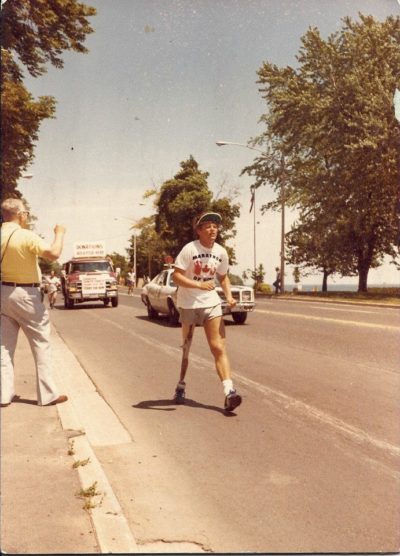 Terry Fox running along LAkeshore yards away from the monument that commemorates the event. During his Marathon of Hope 41 years ago, Terry Fox said, “Even if I don’t finish, we need others to continue. It’s got to keep going without me.”
You are being invited to help keep Terry’s dream alive by joining us for the annual Terry Fox Run on September 19, 2021.
Be part of a powerful movement and get involved in a way that feels right for you! Whether you run, walk, bike or wheel—any way you choose to participate will make a meaningful difference and help us fund critical cancer research.
You can take part wherever you are—around your neighbourhood, backyard, down the street, or around the block. We will unite in spirit across the country and collectively raise funds for cancer research in honour of Terry’s enduring legacy.

 By Staff By Staff
July 28th, 2021
BURLINGTON, ON
Bell Canada is paying local artists to decorate the connection boxes that are spread throughout the city.
No idea yet how many there will eventually be – the photograph sent us by a Gazette reader is being installed in front of the Performing Arts Centre

This a one is across from BPAC on Locust St. The artist has been working away on this for several days now.

 By Ryan O’Dowd By Ryan O’Dowd
July 28th,2021
BURLINGTON, ON
Throughout August the Joseph Brant Hospital Foundation (JBHF) will showcase local artists to raise funds with a big boost from Burlington Artscape.
The initiative features fifty local artists who have painted 4 foot leaf-shaped canvases with a unifying theme of the love of Burlington.
Ashley Davison, the Chief Development Officer with the JBHF, spoke about the love of Burlington theme, at a time when a celebration of city and community seems particularly poignant.
“Bringing people together to create beauty out of a time when things have been so challenging might be a nice way to celebrate nearing the end of the pandemic and to start to bring life and beauty back to the community through the installation.
“Many local artists have a connection to the hospital and Burlington. Burlington Artscape marries the art with the beauty of Burlington, as well as the pivotal role the hospital has played over the last 18 months, meeting the needs of our community at a time when they’ve never been needed more.”
Burlington artist Jodi Harrison founded Burlington Artscape in 2021 to support the hospital with the help of the art community. August 8th,15th and 22nd are dates for an outdoor showing of all the completed leaves. It will run from 10am to 4pm at Grace United Church located at 2111 Walkers Line, Burlington. Leaves will be available to order August 7th, 2021 at 8 a.m. Orders will be available online or at the outdoor art shows.
Although COVID-19 added considerable pressure to the hospital, Annisa Hilborn, the president of the JBHF, pointed out that the need for corporate and community support is constant – taxes don’t cover everything.
 Annisa Hilborn, President of the Joseph Brant Hospital Foundation “If we all come together to support our public health care system it’s only going to get better,” said Hilborn. “The pandemic reminded our community of the need and urgency to support these important foundational elements of our society, to ensure we are a healthy society and get through things like the pandemic…and when it’s not the pandemic it’s something else that’s coming.”
“The theme resonates with the feeling of the last 18 months,” Hilborn added, “there’s a greater appreciation of the community getting together because we wouldn’t have been able to get through what we’ve gone through unless everyone participated. We say at the hospital, ‘we’re here in the moments that matter’ and we ask that the community be there for us too.”
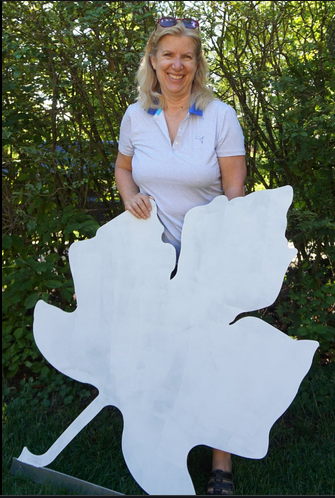 Cathy Lorraway with the leaf shaped canvas she will paint on. The 50 leaf-shaped canvases will be on display on the 8th, 15th, and 22nd of August at Grace United Church. The artwork is available for purchase now for $750 which will go toward Burlington Artscape’s goal of $37,500. 100% of proceeds will go to support the critical needs of the hospital.
COVID-19 safety precautions have been taken for the event.
Hilborn and Davidson praised community support throughout the pandemic but are looking forward to future events in person as restrictions loosen.
“We’re on our toes about it, responding as the regulations and guidelines change,” Davidson said, “seeing where we can, safely and responsibly, have people interacting in person because I think the community will be ready for that.”
The featured paintings can be viewed now on Burlington Artscape’s website and their Instagram account.
Many paintings depict lively visions of Burlington, a bustling Spencer Smith Park, the Burlington Teen Tour Band marching, a crowded beach, distantly familiar after 18 months of the pandemic.
As the city opens and Burlington Artscape calls upon the community to celebrate and be celebrated perhaps the city has turned over a new leaf.

 By Pepper Parr By Pepper Parr
July 27th, 2021
BURLINGTON, ON
It is worth going back and reviewing where things were before the current city council was elected and recalling what the issues and objectives were when a study was to be done on how the Waterfront Hotel site was to be developed.
At the time, June 2018, “a clear consensus on direction had not yet been achieved.” An election was about to take place which put a lot of work on hold.
The Planning department wanted some direction from Council and asked for a Staff Direction.
The Gazette reported at the time that:
The Waterfront Hotel planning study will guide the property owner in the redevelopment of this site. Located next to two of Burlington’s most significant landmarks, Spencer Smith Park and the Brant Street Pier, input from residents is needed to ensure the new development reflects a high quality of urban design that enhances the community’s access to the waterfront and the downtown.
The planning staff had asked council to “endorse the key policy directions”. Those directions are set out below:
Extensive engagement was done through three community workshops (a total of six sessions), the Planning and Development Committee held on November 28, 2017, and significant contributions from the Vrancor Group and the Plan B Citizen Group were relied upon to create key policy directions to move forward.
Waterfront concept 1
 Concept 1 from the city planning department: – the buildings are much closer to Lakeshore and the height will disturb a lot of people. The key policy directions for the Waterfront Hotel site are intended to align with the vision statement, accommodate an iconic landmark building, and reinforce the site’s unique location as a major gateway to the waterfront.
Waterfront – Concept 2
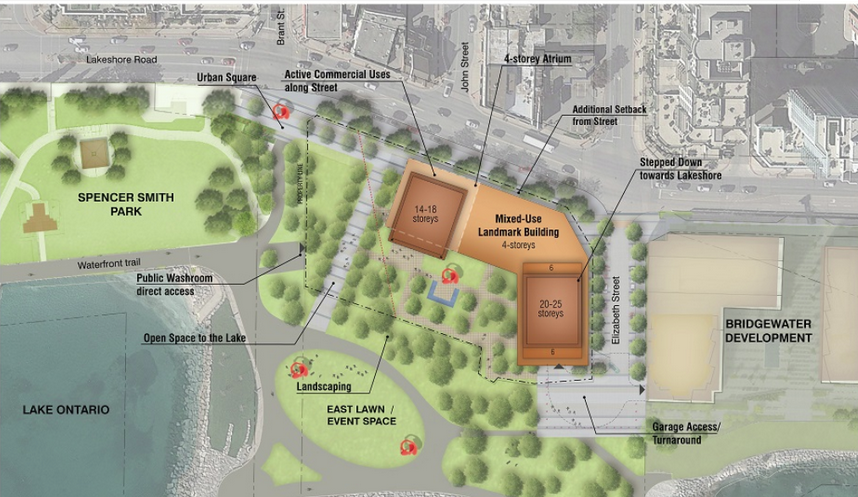 Concept 2 from the city planning department shifts everything to the right creating a much more open approach to The Pier. The city produced two concepts, neither of which gained all that much traction. A small group who live in the downtown core didn’t like the way the city was handling public participation – they came up with ideas of their own that have shifted some of the thinking being done by the planners. PLAN B, the name of the citizen’s group, took a much different approach suggesting that a red Line starting at the NE corner of Brant and Lakeshore become the demarcation from which there are no building West/ Southwest of the red line.
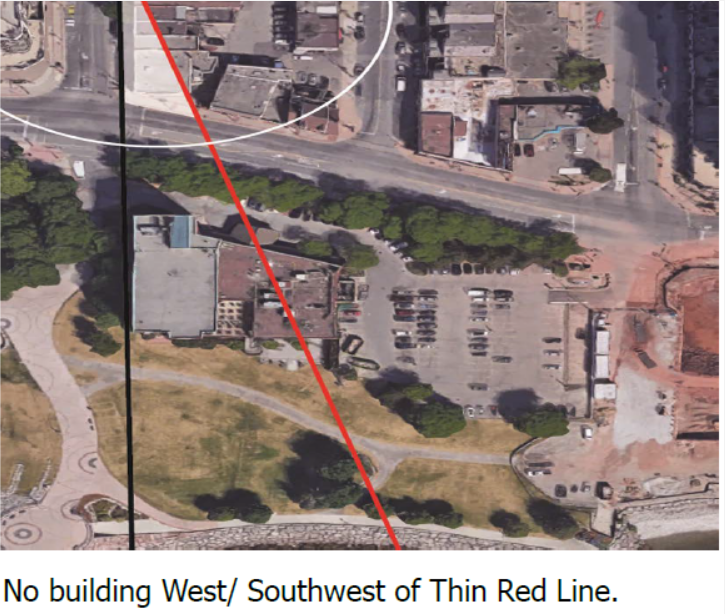 The objective of the citizen group thinking was to create a clear generous view from Brant and Lakeshore out to the lake. Don Fletcher, spokesperson for the group, explained the concerns that included:
the adopted OP for downtown and the intensification designations will impact the application and approval of the Waterfront Hotel redevelopment
The participation that Fletcher saw at the Citizen Action Labs sessions caused the Plan B people additional concern about the process and that both City Concepts 1 & 2 seem designed to meet same intensification goals as former Adopted OP – LPAT defensible.
– Tall buildings permitted in Lakeshore Mixed Use Concept 1 at both NE corner w/Brant & NW corner w/Locust transition poorly to neighbouring precincts, but yield higher density
– Podium setback in Lakeshore Mixed Use Concept 2 of only 3m is to compensate for lower density of mid rise building
Fletcher believes that the electorate voted on Oct. 22nd, 2018 for fundamental change to intensification levels and the enforce-ability of the Official Plan.
He concludes that key OP policies should:
– Preserve connections & views to the waterfront
– House mid- to low-rise buildings downtown with taller ones toward Fairview
– Maintain small town character and preserve heritage
– Reflect the community’s vision for the area
Fletcher argued that many attendees at Citizen Action Labs viewed Concepts 1 & 2 as different versions of same over-development and added that a different result from the 2018 Adopted OP demands a different approach.
Citizens’ PLAN B proposes that the city continue to refine recommended Concept (1+2)
Create an alternate What-if Concept to support growth downtown, without Mobility Hub/ MTSA and Urban Growth Center designations and accelerate Land Use Study and publish the report.
Some of what Fletcher wanted has come to pass – the bus terminal is just that – not a Major Transit Station Area (MTSA) and the Urban Growth Centre boundary has been moved north.
Policy Directions
The key policy directions have been organized around the study’s three frameworks and guiding design principles of Land Use and Built Form, Public Realm, and Mobility and Access, as follows:
Land Use and Built Form
1) Create building frontages along Lakeshore Road and Elizabeth Street with building placement that establishes a defining street wall and frames the street zone.
2) Provide active uses at grade along Lakeshore Road and Elizabeth Street.
3) Achieve active and animated edges adjacent to Spencer Smith Park, with a requirement for retail and service commercial uses at grade:
a. Built form next to the south property line shall activate and animate this edge, respect the existing grade, and be scaled to the waterfront trail with higher levels stepping back as necessary.
b. Built form next to the west property line shall activate and animate this edge, respect the existing grade, and be scaled to Spencer Smith Park with higher levels stepping back as necessary.
4) Require a minimum of two uses within buildings and where feasible, encourage three uses.
5) Establish an iconic landmark building on the site subject to the following:
a. A new public, pedestrian space is provided at the foot of Brant Street where public views to the Lake and Pier are enhanced;
b. The iconic landmark building must contain a destination use or function;
c. The iconic landmark building shall enhance the City of Burlington’s image/identity.
6) Require design excellence in all matters of architecture, landscape architecture, sustainable and urban design and require that all public and private development proposals on or adjacent to the site be evaluated/reviewed by the Burlington Urban Design Advisory Panel.
 At one point what was called an “Emerging Concept” was on the table. Wow – that s one whack of development. Public Realm
7) Protect public view corridors to Lake Ontario from Brant and Elizabeth Streets, and, where possible, John Street.
8) Enhance the Brant Street view corridor to frame views to the Brant Street Pier, and require a significant building setback from the west property line.
9) Create new and enhanced publicly accessible green/open space, which would include new north-south pedestrian connections between Lakeshore Road and Spencer Smith Park (mid-block and along the site’s edges).
10) Minimize changes to the existing grade along the southern edge of the site and enhance the interface with Spencer Smith Park.
11) Integrate a public washroom within the future redevelopment; with an entrance that is accessible, highly visible and within close proximity to Spencer Smith Park.
12) Identify opportunities for the placement of public art on, and adjacent to, the site.
13) Vehicle access shall be from Elizabeth Street.
14) Vehicle access from Brant Street will be closed and converted to a pedestrian orientated gateway to the waterfront.
15) All required on-site parking shall be provided underground (parking structures shall not be visible from the public streets and park).
Council is going to be consumed with coming up with a budget that the taxpayers don’t choke on. As they get into 2022 their focus will become more political and their energy will go into getting elected.
Will any attention be paid to getting a decision in place on just what is to happen to the Waterfront Hotel site before Councillors go into re-election mode?
The Ontario Land Tribunal might have something to say on that.

 By Pepper Parr By Pepper Parr
July 26th, 2021
BURLINGTON, ON
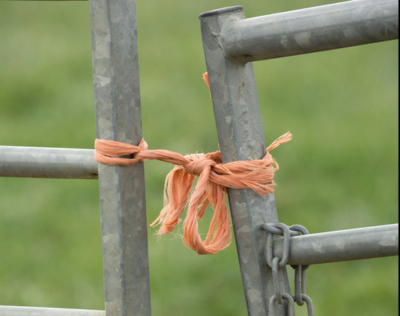 So far the fix to the comments is holding. It took some binder twine and duct tape and there is no guarantee that it will hold all that long – but the comments section has been reopened.
The re-design, using a different design theme, is a work in progress.
Our techie spent hours trying to figure out where the issues were – thinks he has found them. We did trial runs late Sunday and this morning – they are holding.
Thank you for your patience.

 By Staff By Staff
July 26th, 2021
BURLINGTON, ON
At 1:48 pm on Sunday 25th July, 2021, the Halton Regional Police Service responded to a resident reporting a child having drowned in a swimming pool.
 Police and Paramedics were quickly on scene. Lifesaving measures were performed. The child was transported to hospital where he/she remains in a critical condition. Police and Paramedics were quickly on scene. Lifesaving measures were performed. The child was transported to hospital where he/she remains in a critical condition.
An investigation at the scene continues in an effort to determine the circumstances.
Anyone with information regarding this incident who has not yet spoken with Police are asked to contact the Duty Staff Sergeant at Burlington Police Station on 905-825-4747 ext: 2310.

 By Maddy Van Clieaf, Local Journalism Initiative reporter By Maddy Van Clieaf, Local Journalism Initiative reporter
July 23rd, 2021
BURLINGTON, ON
The Burlington Public Library, BPL, has served as a community hub for information, engagement and literacy since 1872. With the unprecedented events of the pandemic, the library has transformed into a space for community support, equity and inclusivity.
 Lita Barrie, CEO and President of BPL Lita Barrie, CEO and President of BPL, and her team of librarians and staff have been working throughout the pandemic with other community groups and libraries to establish comprehensive services that capture the community’s needs.
The library worked in two ways to accommodate the community. Barrie explained that “it was about what we could do in our capacity as the library to help keep our community safe and our staff safe.”
Just as Burlington shifted online, the library closed its doors on March 13, 2020. Staff and patrons alike adapted to the digital format, with the library seeing a 103% increase in eCheckouts.
 This might be social distancing to the extreme. To respond to the increased demand for online services, BPL transformed their website into a ‘virtual branch’ offering a wide variety of staff picks eBooklists, online learning resources and activities for children at home, as well as a list of community resources for those in need.
As well, a partnership with the Mississauga, Hamilton, London and Ottawa Public Libraries boosted BPL’s digital book collection, expanding the total digital collections to 330,000+ titles.
 All the pandemic did for the library was increase the demand for something to read. Barrie continued, “The second way BPL accommodated the community was in trying to adapt to whatever constraints the pandemic was presenting at one time or another to provide meaningful library service. Part of what we tried to reimagine through the pandemic is how we could continue to be open to the community while our physical branches couldn’t be.”
Reimagining the way a library works and functions in the community means the services provided by the library are constantly changing to adapt. They provide for a broad demographic; young kids learning to read, students, and senior citizens.
Maddy Van Clieaf is a second year journalism student at Carleton University. She is with the Gazette as part of the federal governments Local Journalism initiative.

 By Kate Elder By Kate Elder
July 23rd, 2021
BURLINGTON, ON
Although Canada is not considered to be the gambling capital, there are many good casinos, bookmakers, and other gambling establishments operating here. Online casinos are also available to residents of the country. However, you should be aware of the fact that different areas of Canada have their own legislation driving the gambling market. And you need to adhere to your local rules to be 100% sure that you are not breaking the law.
Key Features of the Local Business
The fact the different legislative acts are driving the industry in different states complicates the life of a gambler. You may be legally allowed to make bets in one province but have serious problems because of playing your favourite casino game in a different state. For example, in Alberta, you can participate in gambling if you are 18 years old or older. In British Columbia, it is allowed to make bets at a casino only if you are not younger than 19.
The situation is completely different in the northwestern regions of the country, where only the government lottery is legal. To stay on the safe side, you need to check local gambling laws and stick to them. The same refers to playing online slots here — you either need to clarify the legal status of online gambling or start the game on the offshore casino site.
The situation is somehow stable for casino owners. In states where casinos are allowed, you can legally become a gambling business owner if you purchase a license. Many new gambling businessmen start their business from scratch. The gaming license is issued by the Alcohol and Gaming Commission of Ontario. Besides that, the government of each Canadian province determines the type of permitted gambling business on its territory. So you should check it out as well.
Local Casinos
In Canada, most casinos and gambling venues offer a decent level of service. Of course, it is difficult to name the best ones since it is rather a subjective matter. However, the below casinos are considered to be the most popular gambling halls in the country:
Northlands Park — The most popular luxury game complex is located in Edmonton. The casino is called Northlands Park. For all visitors, it offers numerous slot machines, table games, and sports betting options;
Medicine Hat Lodge Resort casino — You can find the establishment in Montreal. The casino hosts over a hundred tables and three thousand machines under its roof. Players can place virtual bets at the racetrack and have a great time playing other games of chance. The Medicine Hat Lodge Resort casino operates on the territory of Alberta and is considered one of the largest gambling establishments in Canada;
Casino de Mont-Tremblant — The luxurious Casino de Mont-Tremblant is located in Quebec. This club is renowned for its high level of service and many great deals available for players. The two-level establishment occupies a vast area and includes a thousand slot machines, as well as isolated areas for playing poker.
Of course, Canadian casinos are not as famous all over the world as the establishments in the neighbouring USA. However, each province of the country offers its residents and tourists good gambling clubs. All in all, gambling fans will hardly get bored in Canada.
Industry Level as a Whole
The gambling business in Canada is a huge industry with a massive turnover of 13 billion a year. The development of gaming clubs is actively supported by the state. There is a positive image of gambling here, and the Canadian government follows the successful example of the neighbouring United States in its loyalty to the gambling business. More than 60 casinos in Canada are licensed and equipped with the latest gaming technology. The owners of gambling clubs pay great attention to the quality of customer service and gameplay level delivered.
According to industry experts, the gambling business in Canada can gradually achieve American gambling success. Today, the country’s gambling industry regularly receives investments from foreign businessmen who confidently invest their finances in Canadian gambling establishments.

 By Staff By Staff
July 20, 2021
BURLINGTON, ON
Burlington will open online registration for indoor summer recreation programs for adults 19+ and adults 55+ beginning Saturday, July 24 at 9 a.m.
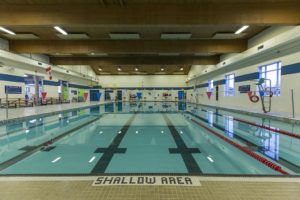
Registration for swimming programs at Tansley Woods, Aldershot, Centennial and Angela Coughlan pools will also open on Saturday, July 24 at 11 a.m.
A complete listing of indoor summer programming can be found online at Burlington.ca/recreation.<
Drop-in programs
Registration for drop-in recreational swimming and skating programs at indoor City facilities is required 25 hours in advance of the program start time. Drop-in swimming programs start today, Monday, July 19, and skating programs will resume Tuesday, July 20.
New self-serve option for withdrawing from drop-in programs

New this season, participants have the ability to withdraw from drop-in programs online by logging into their Live & Play account. More information about the new feature is available online at Burlington.ca/recreation.
All City programs will continue to follow public health guidance when required, including physical distancing, capacity limits and wearing masks or face coverings. Individuals participating in an in-person program will be required to fill out the mandatory health screening form at Burlington.ca/screening before each session.
• Individuals who have questions or require assistance can email live&play@burlington.ca or call 905-335-7738 between 8:30 a.m. to 5:30 p.m. Monday to Friday, and 10 a.m. to 5:30 p.m. on weekends.
• Recreation fee assistance funding is available to resident individuals or families who require assistance with the cost of City of Burlington recreation programs. For more information or to apply, visit burlington.ca/feeassistance. You can also leave a confidential voicemail message at 905-335-7738, ext. 8501 and staff will return your call to assist you.

 By Staff By Staff
July 19th, 2021
BURLINGTON, ON
Like many not-for-profits, Burlington’s Royal Botanical Gardens saw a slump in donations during the pandemic. With their main garden areas and indoor spaces restricted they were forced to close due to COVID-19.
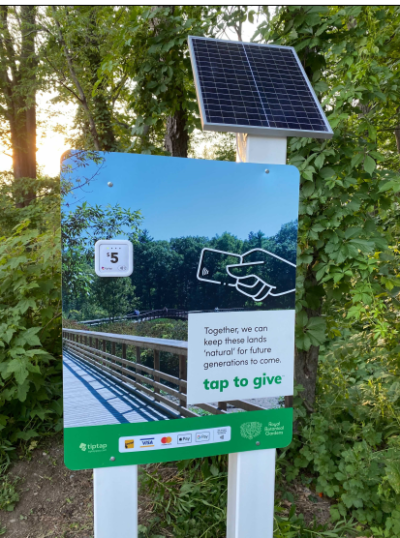 The tap to give technology helps RBG get through a slow period for donations. The trails systems saw a significant increase in foot traffic, which is why they are there.
What RBG wasn’t able to do was solicit donations. They had no means of requesting donations from hikers and walkers.
Then Moneris and a start up brought out their idea.
You may not know Moneris – but they know you. In many places where you use your plastic to pay for something the transaction could be going through a Moneris terminal.
Moneris Canada and the start up, tiptap, helped to install a touchless solar powered device at the entrance of one of their trails.
The device allowed visitors to donate by simply tapping their credit or debit card before starting their walk.

 By Staff By Staff
July 18th, 2021
BURLINGTON, ON
Alan Harrington has been tracking the progress of the tugboat Theodore for weeks.
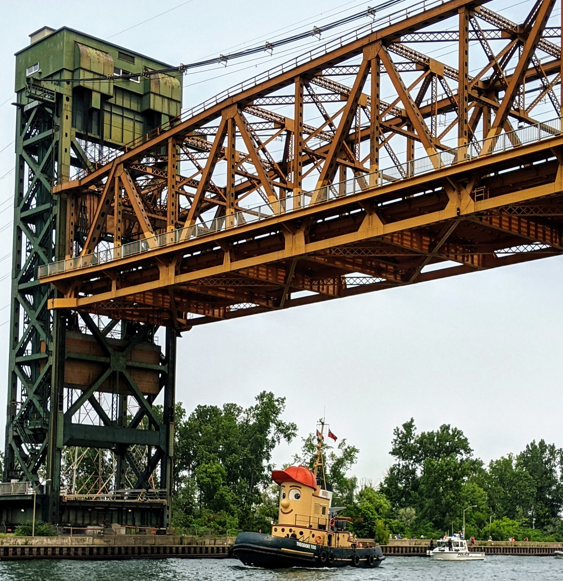 Theodore TOO entering Hamilton harbour It was a long arduous trip with numerous stops along to way – from Halifax to its new home in Hamilton where it will be refitted to do environmental work.
It was bought by McKeil a Burlington marine company.
The boat has a crew of four.
Harrington made sure he was at the canal to capture the picture of the tug entering Hamilton harbour with a police marine unit escort.
It sailed alone from Halifax a few weeks ago and entered the canal with escorts from the police marine unit and a ship from the Coat Guard.
AH

 By Pepper Parr By Pepper Parr
July 17th, 2021
BURLINGTON, ON
An upgrade on the membership of the group that supports a quarry in rural Burlington. We are advised that the membership has written more than 2000 letters of support.
 For the community group opposing the expansion of the Nelson Quarry in rural Burlington the next step is to demonstrate and get their message out. For the community group opposing the expansion of the Nelson Quarry in rural Burlington the next step is to demonstrate and get their message out.
The application by Nelson Aggregates to expand their open pit mine is a long and slow moving process.
City Council has come out against the expansion, there is a small group for the expansion: they don’t appear to have much in the way of community support.
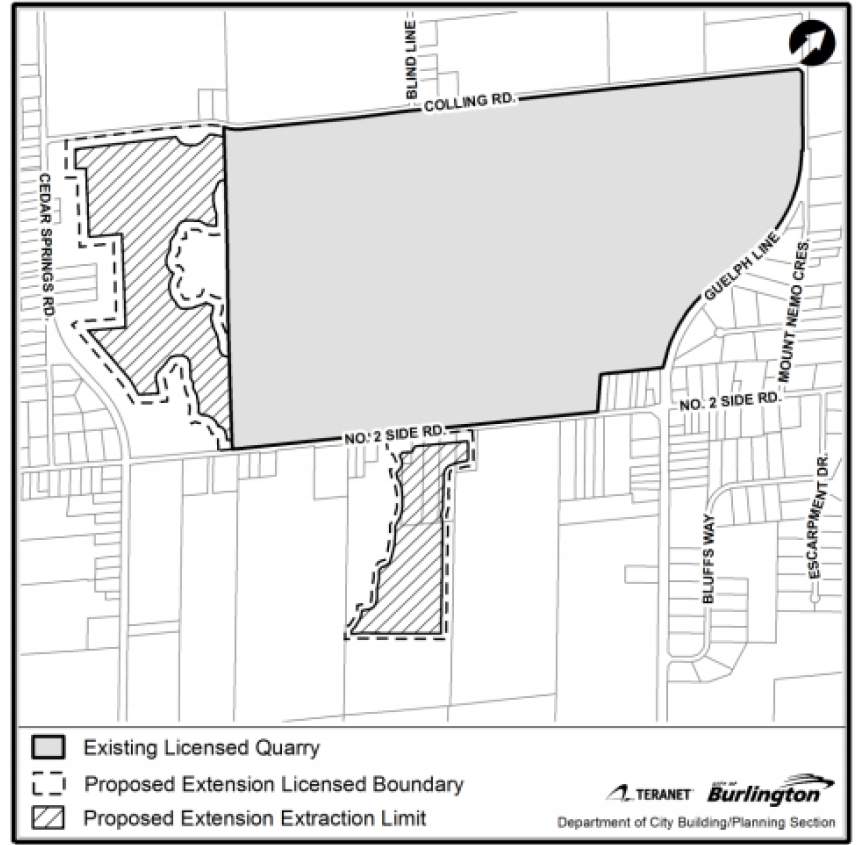
On July 20th, CORE Burlington, PERL and Wellington Water Watchers will be outside the gates of Nelson Aggregates on the 2nd Side Road for A Morning on Mt.Nemo. They will be joined by Shane Philips of Wellington Water Watchers as he continues his ‘Ear to the Groundwater’ walking tour with a visit to the gates of Nelson Aggregate’s open-pit gravel mine, followed by a hike to the scenic brink of Burlington’s Niagara Escarpment.
Why: To raise awareness of the devastating effect open-pit gravel mines have on communities and the environment. Shane will connect the dots between the local and the global issues, and show how gravel mining helps fuel the climate crisis, and how Doug Ford’s agenda for new highways and more urban sprawl will devour our future.
When/Where: Tuesday, July 20th, 10am at 2462 No. Two Sideroad Burlington. Across from the gates of Nelson Aggregate’s 540-acre open pit mine on Burlington’s Escarpment: part of an UNESCO World Biosphere Reserve
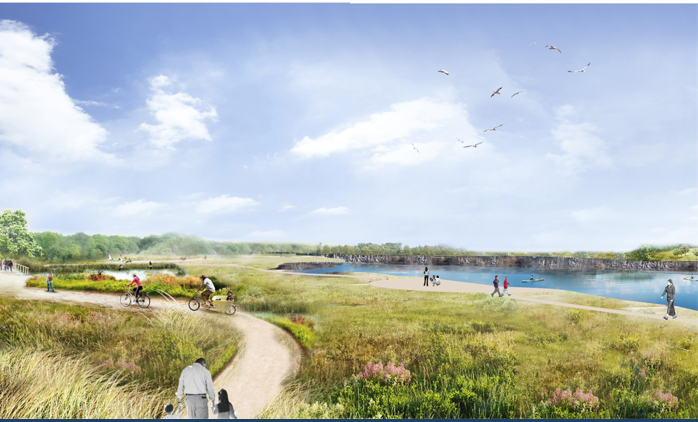 A rendering of what Nelson Aggregates wants to do with the land when they have completed their mining of the available aggregate. Order of Events:
10:00am – 10:30 Speakers, Mike Balkwill, Wellington Water Watchers; Janet Turpin Myers, CORE Burlington; Sarah Harmer, PERL; and Shane Phillips. As a special treat, Sarah will also perform ‘Escarpment Blues’.
10:30 – 11:45 Drive to Mt. Nemo Conservation Area (a few minutes away) for a hike to the brink of the Escarpment, and back again (about a 20 minute walk on an easy trail each way)
NOTE: The Conservation area requires advanced reservations to enter. We will reserve tickets for our group, which we expect will number about 20-30. If you plan to come along for the hike, please RSVP by responding to this email, no later than Monday, July 19th by 9am. This will help us to calculate how many reservations to make.
If you choose not to hike with us, please do join us for the first portion of the morning.
For more information contact: coreburlington@gmail.com
About CORE Burlington: www.coreburlington.com

|
|
 By Staff
By Staff
















 • The Thing Lou Couldn’t Do – by Ashley Spires,
• The Thing Lou Couldn’t Do – by Ashley Spires,
 Max Bowder is a second year journalism student at Sheridan College. He is part of a team with the Gazette on the Local Journalism Initiative funded by the federal government. Before enrolling at Sheridan Max volunteered in a community in Venezuela where he worked with young people. He is a Burlington resident who helps out on the family farm in Milton.
Max Bowder is a second year journalism student at Sheridan College. He is part of a team with the Gazette on the Local Journalism Initiative funded by the federal government. Before enrolling at Sheridan Max volunteered in a community in Venezuela where he worked with young people. He is a Burlington resident who helps out on the family farm in Milton. By Staff
By Staff





 No doubt about it, everyone at the time believed this was a “WIN-WIN” situation. Spencer Smith’s story was a perfect example of one that seemed to have a happy ending.
No doubt about it, everyone at the time believed this was a “WIN-WIN” situation. Spencer Smith’s story was a perfect example of one that seemed to have a happy ending.
 This became an economic issue more than anything else. It was strictly a case of supply and demand. Most of these organizations were faced with a huge demand. They had great difficulty in meeting the demand by farmers and governments in Canada and Australia. It was stated at one time that there were 10 applications for every child. So what were they going to do? The answer was simple. Start rounding up any child who potentially was wayward and lived in the area that was to be scoured for recruits. Overly simplified, absolutely, but not by much.
This became an economic issue more than anything else. It was strictly a case of supply and demand. Most of these organizations were faced with a huge demand. They had great difficulty in meeting the demand by farmers and governments in Canada and Australia. It was stated at one time that there were 10 applications for every child. So what were they going to do? The answer was simple. Start rounding up any child who potentially was wayward and lived in the area that was to be scoured for recruits. Overly simplified, absolutely, but not by much.
 They were forced to live in exclusion on the farmer’s property, and not interact with the farmer’s own children or have any friends of their own. They were not loved or nurtured in any way. We know that they were constantly tormented and bullied by other children at local schools, and even adults participated in this human degradation of these children. We know that many just eventually disappeared. Where you ask?
They were forced to live in exclusion on the farmer’s property, and not interact with the farmer’s own children or have any friends of their own. They were not loved or nurtured in any way. We know that they were constantly tormented and bullied by other children at local schools, and even adults participated in this human degradation of these children. We know that many just eventually disappeared. Where you ask? Albert had just arrived from England with many other British Home children and they all disembarked at Halifax from the ship Albertic on March 17, 1930.
Albert had just arrived from England with many other British Home children and they all disembarked at Halifax from the ship Albertic on March 17, 1930. Where do we stand? Sadly, and unfortunately, the Canadian Government has essentially taken the position that this isn’t really a big deal, and no apology is warranted or forthcoming, even though they backed and encouraged this form of child slavery and abuse under the guise of helping disadvantaged children. Personally, I think that Jason Kenney the Cabinet Minister responsible for these remarks was not that well informed on the situation when confronted with the apology question, and consequently brushed it off as unimportant. I encourage you to contact Burlington’s local Federal Member of Parliament, Mr. Mike Wallace, who is a very decent man, and please voice your concern. I would like to think that Mike can champion this cause and help us get this apology from the Canadian Government. It’s long overdue, and it’s the right thing to do.
Where do we stand? Sadly, and unfortunately, the Canadian Government has essentially taken the position that this isn’t really a big deal, and no apology is warranted or forthcoming, even though they backed and encouraged this form of child slavery and abuse under the guise of helping disadvantaged children. Personally, I think that Jason Kenney the Cabinet Minister responsible for these remarks was not that well informed on the situation when confronted with the apology question, and consequently brushed it off as unimportant. I encourage you to contact Burlington’s local Federal Member of Parliament, Mr. Mike Wallace, who is a very decent man, and please voice your concern. I would like to think that Mike can champion this cause and help us get this apology from the Canadian Government. It’s long overdue, and it’s the right thing to do.


































 Another family from Weymouth, England were the Judds. They became the travelling companions of the Hodge family, and shared a compartment on the ship below deck. There was a low partition between the 2 families, and bunk beds for both. Edith recalls being mischievous on the long trip. “They used to call me down for everything.” Edith tells of the 2 families reading aloud to each other, often praying and singing.
Another family from Weymouth, England were the Judds. They became the travelling companions of the Hodge family, and shared a compartment on the ship below deck. There was a low partition between the 2 families, and bunk beds for both. Edith recalls being mischievous on the long trip. “They used to call me down for everything.” Edith tells of the 2 families reading aloud to each other, often praying and singing.








 By David Pringle
By David Pringle


 • Hence, Travel and the staycation for 180 days with Korean ETA has been allowed under general covid-19 with a mask and proper sanitization with providing a negative report in every Check Point within 72 hours of landing into Korea.
• Hence, Travel and the staycation for 180 days with Korean ETA has been allowed under general covid-19 with a mask and proper sanitization with providing a negative report in every Check Point within 72 hours of landing into Korea.

 By Staff
By Staff
 By Ryan O’Dowd
By Ryan O’Dowd

 By Pepper Parr
By Pepper Parr




 Police and Paramedics were quickly on scene. Lifesaving measures were performed. The child was transported to hospital where he/she remains in a critical condition.
Police and Paramedics were quickly on scene. Lifesaving measures were performed. The child was transported to hospital where he/she remains in a critical condition. By Maddy Van Clieaf, Local Journalism Initiative reporter
By Maddy Van Clieaf, Local Journalism Initiative reporter


 By Kate Elder
By Kate Elder

 By Staff
By Staff

 For the community group opposing the expansion of the Nelson Quarry in rural Burlington the next step is to demonstrate and get their message out.
For the community group opposing the expansion of the Nelson Quarry in rural Burlington the next step is to demonstrate and get their message out.





